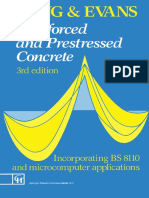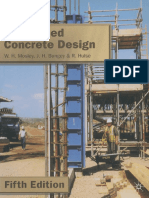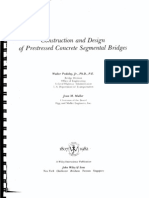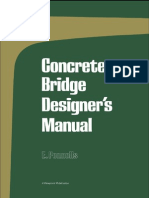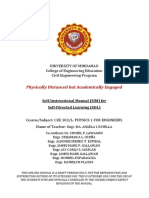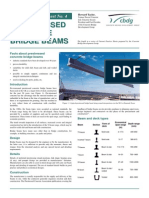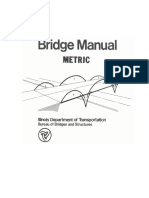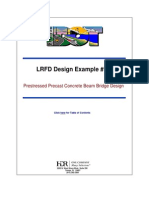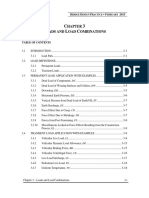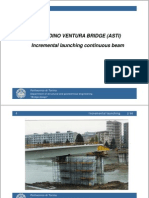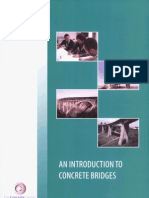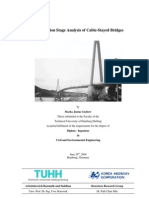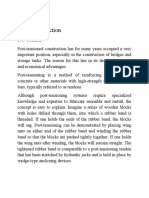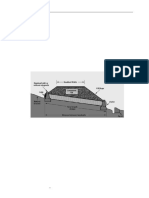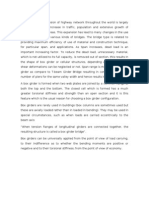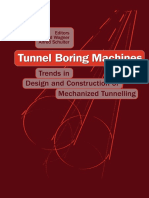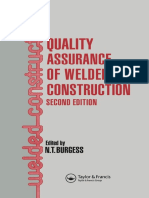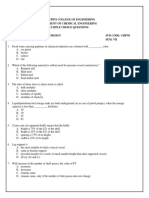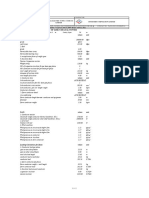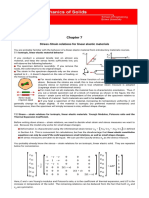Simple Bridge Design Using Pre Stressed Beams Deck (Pca)
Simple Bridge Design Using Pre Stressed Beams Deck (Pca)
Uploaded by
mekkawi6650Copyright:
Available Formats
Simple Bridge Design Using Pre Stressed Beams Deck (Pca)
Simple Bridge Design Using Pre Stressed Beams Deck (Pca)
Uploaded by
mekkawi6650Copyright
Available Formats
Share this document
Did you find this document useful?
Is this content inappropriate?
Copyright:
Available Formats
Simple Bridge Design Using Pre Stressed Beams Deck (Pca)
Simple Bridge Design Using Pre Stressed Beams Deck (Pca)
Uploaded by
mekkawi6650Copyright:
Available Formats
r
Simple Bridge Design
• usmg
Prestressed Beams
An introduction to the design of simply-supported bridge decks using prestressed concrete bridge beams
BA
NICHOLSON
ISBN 0 95000347 2 X © Prestressed Concrete Association 1997
Prestressed Concrete Association 60 Charles Street Leicester LE 1 1FB
Typeset by B. A. Nicholson. Design by G. Ballantyne. Printed by Uniskill Ltd.
CONTENTS
FOREWORD
1 2 2 4 6 6 8 12 14 14 14 16 18 20 22 24 26 26 26 28 32 32 32 36 38 38 38 40 44 44 44 46 50 56 60 66
STANDARD BEAMS 1.1 History 1.2 Bridge deck types 1.3 Choice of section 1.4 Standard sections 1.5 Practical site considerations BEAM & SLAB DECK DESIGN EXAMPLE GRILLAGE MODEL 3.1 Introduction 3.2 Suitability of Grillage Analysis 3.3 Grillage models for prestressed beam decks 3.4 Deck idealisation 3.5 Section properties 3.6 Edge stiffening 3.7 Torsion CALCULATION OF LOADS Introduction Definitions Highway loading Wind load Pedestrian live load Temperature effects Shrinkage APPLICATION OF LOADS 5.1 Load Combinations 5.2 Selection of Critical Load Cases 5.3 Input to Grillage Analysis PRESTRESSED BEAM DESIGN 6.1 General 6.2 Design Bending Moments 6.3 Serviceability Limit State 6.4 Prestress losses 6.5 Ultimate limit state 6.6 Shear 6.7 Longitudinal shear
2 3
4.1 4.2 4.3 4.4 4.5 4.6 4.7
5
FINISHINGS 7.1 Introduction 7.2 Bearings 7.3 Waterproofing and surfacing 7.4 Joints 7.5 Parapets SOLID SLAB DECK DESIGN EXAMPLE
68 68 68 80 82 84 86 86 88 90
8.1 Introduction 8.2 Grillage analysis 8.3 Design of transverse reinforcement
FOREWORD
For several years, the Prestressed Concrete Association has run a basic course on prestressed concrete bridge design. This one day course has been held in various parts of the country, and uses lecturers both from within the PCA member companies and from outside consultants. This book contains a development of some of the material presented in the course. The original course notes were prepared by H. 1. Lloyd, 1. M. Gibb, and A. E. Gamble. This book has been prepared by B. A. Nicholson based on the material in those course notes. The bulk of the book takes the form of a worked example of the design of the beams for a simply-supported single span beam-and-slab deck. The final section is a partial design example of an inverted T beam deck, included in order to illustrate the extra calculations required for a solid slab deck. By following the worked examples, together with the additional commentary, it is hoped that the reader will be able to design simple bridges using standard precast beams, whether they are of beam- and-slab, or solid slab construction.
"- -----=z-SIMPLE
BRIDGE DE5IGNPSING PREStRESSEDBEAMs~
STANDARD BEAMS
1.1 HISTORY
The use of precast prestressed beams in bridge decks in the post World War II era owes its success in the main to the foresight of the Prestressed Concrete Development Group, which in the 1950's developed the first standard beam sections to be available from the beam manufacturers. This enabled factory production of the beams on a large scale, and, with the dawn of major road construction in the late 1950's and its philosophy of grade separation for motorways and trunk roads, it gave bridge engineers scope to rationalise design procedures using up-to-date load distribution theories. The standard beam sections available at that time have of course themselves been developed and modified, and in essence only one really remains today with any significant usage. This beam, the inverted T beam, is used in bridge decks in spans up to about 20 metres. With the rapid development of the UK motorway network in the 1960's, it was clear that there was scope for a standard beam that would enable larger spans to be achieved. Consequently, at the end of the decade a new beam was introduced for spans from about 15 to 30 metres. This was designated the M beam, due to its width and intended spacing. These beams were intended for use in pseudo-slab bridge decks with a contiguous concrete bottom flange using transverse reinforcement located through lower web holes at 600mm centres along the beams. Eventually engineers realised that the M beam could be used more efficiently in beam and slab decks by eliminating the bottom in-situ concrete and by spacing the beams apart at up to 1.5 metre centres. The limitation on this type of use proved to be the shear capacity of the beams, which have a web thickness of only 160mm. Other beams developed around this time were the U beam for beam and slab decks up to about 30 metre spans, and a U shaped variation of the M beam for use as edge beams in M beam decks. Eventually, with the very popular M beam being used in a manner somewhat different from its intended use, and bearing in mind the various problems and limitations this presented, a new beam was developed by the Prestressed Concrete Association in the late 1980's. This was designated the Y beam. The Y beam now has three variants: the TY beam, the Y beam, and the SY beam. Together these cover all span ranges up to 45m. It is expected that in due course inverted T beams and M beams will cease to be used in favour of the enhanced properties of the Y beam ranges.
STANDARD BEAMS
Inverted T beam
M beam
U beam
TY beam
Y beam
SY beam
4 SIMPLE BRIDGE DESIGN USING PRES I RESSED BEAMS
1.2 BRIDGE DECK TYPES
Concrete bridge superstructures using precast prestressed concrete beams fall into three distinct types: slab decks, pseudo-slab decks, and beam and slab decks. Slab Decks Slab decks can be solid or voided, and provide simply supported spans of up to 20 metres. These decks use standard TY or inverted T beams placed side by side. The space between them is then filled with in-situ concrete, and an overall covering of 75mm completes the deck. Continuity of these decks can quite easily be achieved by using reinforcement in the in-situ concrete over the supports. Suspended spans using TY beams or inverted T beams can be lightened by introducing void formers into the space between the beams. Pseudo-slab Decks This type of bridge structure is currently not quite so popular. Precast beams are incorporated into a voided slab type of deck by either adding an in-situ bottom flange and top flange, as with the original M beam decks, or by using voided beams (e.g. box beams). A voided slab deck is thus created without the inconvenience of temporary works and soffit shutters, and provides a torsionally stiffer deck than ordinary beam and slab decks. Spans for this type of bridge deck are usually limited by the length of precast beams that can be transported to site, and therefore are rarely more than 30 metres. Beam and Slab Decks The most common type of superstructure for small to medium span bridges, this type of deck comprises individual precast beams at discrete centres with an in-situ concrete top flange. M beams, TY beams, Y beams, SY beams, and U beams can all be used in this form of construction. With most of the standard range of precast beams the in-situ concrete top slab is cast into permanent formwork which is located in recesses formed in the edges of the top flanges of the beams. Typical spans for this type of deck are similar to the pseudoslab decks above, being limited in the main by transportable beam components. Standard edge beams are available to complement the Y beam, TY beam, and M beam ranges. These provide a vertical visible face, and have the capacity to carry the extra loads from the parapet cantilever.
This solid slab deck uses 19 T2 beams. Service ducts are included in the infill concrete between the beams.
This bridge deck uses nine U5 beams at a spacing of 1.72m. Service ducts run under the footpath. A carrier drain runs through one of the U beam cells.
This bridge deck uses seven Y8 internal beams at a spacing of I.275m, and YE8 edge beams on each side. Service ducts run under the footpath.
1.3 CHOICE OF SECTION
For the types of superstructure indicated above, the beam manufacturers provide standard details of the individual sections and their ranges together with an indication of typical span ranges for decks incorporating these beams and carrying standard highway loads. There will obviously be situations where the choice of deck type is not clearly indicated by the available span, and it is also inevitable that there will be areas of overlap where the choice between inverted T beams in a slab deck or individual M or Y beams in a beam and slab deck may not be clear cut. In this situation it may be necessary to evaluate more than one solution, and the standard sections enable a swift selection of the available ranges for comparative design exercises to be undertaken and cost comparisons made. It is also possible within the standard range of each beam type to be in a span range that is covered by more than one specific beam unit. In this situation it is usually cost effective to select the larger unit where there are no restrictive limitations on headroom.
1.4 STANDARD SECTIONS
Design Although the various types of standard beam sections are well documented in terms of dimensions and structural properties, it is important to point out that these factory produced beams are standard only to the extent that they are manufactured using standard shaped sections. The amount and magnitude of prestress applied to each beam is dependent on its individual situation, and must be determined by the designer prior to manufacture. The standard sections show where prestressing strands may be located, but it is the responsibility of the designer to determine which of these are to be used. In their literature, the manufacturers give suggestions for good design details. These should be adhered to, as they lead to economy and good workmanship. Manufacture Precast prestressed beams are manufactured in long lines of several units using straight strands. These are debonded for varying distances at the ends of each beam within the mould. This is necessary to maintain the stress in the beam at an acceptable level as the self-weight bending moment reduces approaching the supports. Once the concrete in the moulds reaches the minimum transfer strength, detensioning can take place, the strands between the beam can be cut, and the beams removed the storage area prior to delivery to site.
STANDARD BEAMS
Span in metres: Yl Y2 Y3 Y4 Y5 Y6 Y7 Y8
12
14
16
18
20
22
24
26
28
30
32
Beams at 1m centres
Beams at 2m centres
Beam selection chart for the Y beam range, taken from PCA literature.
----1300 -----1200 -----1100 -----1000 900
800
+ ++ +++ ++
+ + + +
+ + + +
++ +++ ++++++++ +++++++++ + + +++++
260 --210 --160 --110 60 0
Standard positions for prestressing strands in a Y8 beam. It is up to the designer to decide which of these strand positions to use.
8 SIMPLR BRIDGE DESIGN OSING PRES I RRSSED BEAMS
1.5 PRACTICAL SITE CONSIDERATIONS
Handling Beams are usually manufactured with lifting loops, thus enabling on site lifting to be achieved with either single or twin cranes to suit the site requirements. However, TY beams and inverted T beams are usually lifted using a sling through the end web holes. Access to Site It is of obvious importance that there is suitable access to the bridges in order for the beams to be delivered and lifted off the trailer by suitably located cranes. Of course, this also applies to the route to the construction site which must allow the delivery lorries to manoeuvre their lengthy loads. There is generally no problem in the transportation of beams of the lengths described in this book. Camber Variation in camber of prestressed beams is inevitable when one considers the tolerance in prestress force and location, together with possible variation in concrete properties with maturity and climatic conditions.
It would therefore be impracticable to specify any limitation on camber values, although a tolerance on camber variation between beams has been adopted. However, it should been borne in mind by the designer that an occasional failure to meet the specified tolerance on soffit level variation does not result in impossible construction conditions. The careful positioning of adjacent beams in a deck should nearly always result in an evening out of differential camber.
Edge Details On site, construction of parapet string courses in one or more stages generally follows the construction of the central deck slab area. This necessitates the formation of a construction joint along the edge beam prior to constructing the fascia. Alternatively, it is sometimes possible to construct the fascia as a second stage casting in the manufacturer's yard, prior to delivery to site as an almost complete unit. One advantage of this is that the beam can be propped quite easily at the works, thus enabling stresses in the precast beam section to be minimised.
r-----<
This section can be cast on site as a second stage after the rest of the deck, or alternatively can be cast onto the UM beam by the manufacturer so that the edge beam and parapet can be brought to site as a single unit.
Construction joint
UM8
I
I
Second stage in-situ concrete
,- - - - - - -
-"'-----------------
First stage in-situ concrete
T2
Cast by manufacturer
Two examples of edge details
10 SIMPLE BRIDGE DESIGN OSING PRES I RESSED BEAMS
Skew Although it is possible to manufacture precast beams with skew ends, the increase in cost for each unit and the problems that skew presents should be considered in detail at the design stage. Firstly, it should be remembered that even a very small change in skew angle requires a new stop end for the mould. A change from say 30° to 31° increases the width by 12mm for an M beam. To rationalise a range of angles with a variation of 10°, say, would be a useful and economic possibility. Structural problems created by skew in the ends of precast beams relate specifically to the acute comer, where the formation of cracks can cause the comer of the flange to spall when the beam cambers during transfer. Although not structurally significant, this is undesirable, and is best prevented by blocking out the comer to give a local square end. An additional problem that presents itself with skew beams is that oflocating transverse reinforcement through the web holes. It is recommended that the standard web holes permit reinforcement to be placed for skews up to about 35°. Higher skews than this would require special non-standard web holes, which would increase the cost of the beams significantly, and may even affect the shear capacity ofthe section. For high skew bridges, it is normally better to place the transverse deck reinforcement at rightangles to the beams rather than parallel to the abutments. Transverse Reinforcement For the transverse reinforcement through the web holes of precast beams, it is usually better to use a number of smaller bars rather than a single large diameter bar, as lap lengths are reduced and handling becomes easier. For some awkward skew situations it may even be sensible to use untensioned prestressing strand threaded through the web holes instead of reinforcing bars, as it is more flexible. The positioning of transverse deck reinforcement when using solid edge beams may require the use of couplers at the edge beam interface. Temporary Support It is important to ensure that the beams are supported so that they cannot topple over on site. Deeper beams, particularly when being jacked to their final level and during bearing installation, must be assessed to eliminate this risk.
r--------------tD~~~
Diaphragm
~
I I I
I I I I I
Mbeam
L...___ __
~-------
Web hole at end of M beam, for diaphragm reinforcement
Local square end to Mbeam 330 wide
Diaphragm 800 wide
M beam bridge deck with 45° skew. Diagrams show ends of M beams embedded in a diaphragm.
12 SIMPLE BRIDGE DESIGN USING PRES l'RESSED BEAMS
BEAM & SLAB DECK DESIGN EXAMPLE
Sections 3 to 7 of this book consist of a design example of a beam and slab deck. This design example shows the typical sequential calculations necessary for the full design of a precast pretensioned concrete Y beam in a simply supported beam and slab bridge deck. The right hand pages show the numerical calculations involved at each stage, and the left hand pages contain explanatory comments and further information. The example bridge has the following design requirements: Span Width Loading Surfacing 26.61m single span 7.3m carriageway, plus 1.0m hard strip each side 1.5m footpath each side HA plus 37.5 units HB 100mm thick (minimum) plus 20mm waterproofing
The following materials will be used: Precast concrete In-situ concrete Prestressing strand feu = 50 Nzmrn' = 40 Nzmm? feu = 40 Nzmm'
fei
15.2 mm diameter Dyform strand fpu = 1820 Nzmnr' Area = 165 mm' per strand
The edge detail was chosen for aesthetic reasons, and the outer beams placed as near to the edges of the bridge within this limit. This led to the beam spacing of 1.275m. The span charts for Y beams give spans for beams at 1 and 2 metre spacings. It is straightforward to interpolate from this information to make an initial selection of beam size, in this case Y8. Clearly alternatives would have been possible, for example eleven Y6 beams could have been used, at about 1 metre spacing. However, it has been found that unless it is necessary to make the deck as shallow as possible, it is usually preferable to use fewer but larger beams.
13380
Overllli ldtlr w
Foot(lt1t/r
540 1500
fit1rd
strip
fit1rd
strip
root,Mtlr
1500 540
1000
1000
Crogg sect/Of! Of bridge deck for deslgf! e~#!I'/e
14
SIMPLE BRIDGE DESIGN USING PRES I RESSEl) BEAMS
GRILLAGE MODEL
3.1 INTRODUCTION
Early bridge decks were analysed on a strip basis. Abnormal and wheel loads were crudely distributed and conservative designs resulted. Experimental data became available to determine the transverse load carrying characteristics of decks to determine the correct level of transverse strength provision and to distribute load more logically to the longitudinal members. For example, in the 1950's Morice and Little developed a Distribution Coefficient method which was a simple hand method based on experiments which allowed for the overall distribution of loads on a plate structure such as a bridge deck. It was satisfactory for skews up to 20°. This method was one of several similar techniques extensively used in design offices for approximately 15 years, until the advent of computer techniques which enabled larger and more complex structures to be analysed more accurately using grillage, finite strip and finite element methods. Of these three methods grillages offer the widest range of structures which can be analysed. Popular opinion suggests they are also the easiest to use and understand. No analysis method gives a rigorous solution, and some degree of error must be accepted, usually ranging up to 10% or 20% depending on complexity. These errors come from several sources, including the idealisation of the geometry and material properties, and idealisation of the structural behaviour. Grillage analysis has found favour as a bridge engineer's design tool because it is perceived to have the following advantages: • Grillage beams can be positioned to correspond with physical beams in the real structure, or where maximum effects are anticipated. • Modem PC versions have 'user friendly' input, often designed by engineers, and use pre- and post-processors to ease subsequent checking, searching and analysis. • Familiarity of use in the design office enables rapid analysis and checking, which is vital in a competitive market. • Programs are relatively cheap, thus making analysis economic.
3.2 SUITABILITY OF GRILLAGE ANALYSIS
The method can be used for structures with beam and slabs decks, voided slabs or solid slabs. It can be used for simple and continuous bridges, and allow for elastic supports and settlement. It is suitable for right, skew and curved decks. This range covers hundreds if not thousands of bridge decks designed in recent times, and certainly covers all bridges with prestressed beams.
Tltis bridge will be tllltllljsed witlt tl gnlltlge tllltllljSiS. TltetllltllljSiS will beferformed IIsillg tlte comfllter frogrtlm '~TAAD 111/ ISDS" (rom R.esetlrclt btgilleers (f.IIrofe) Limited
Silll COllvelftioll Tltis tllltllljSis IISes a rigltt-Ittlllded ortltogolltll sljstem of tlx.es. Tltegnlltlge lies III tlte X-Z fltlll&, tllld tlte 'f-tlX/s is vertictllllj IIfwtlrds, Lotldillg will be tlfflied ill tlte lIegtltlve 'Idirection.
toea! tlx.es tlre IIsed for belldillg momellt III members, etc. /11 this case tlte X-tlX/s rllllS tllollg tlte lellgtlt of tlte member, tllld tlte '1-tlx/s is stili vertictllllj IIfwtlrds. TlteZ -t1X/slies ill tlte fhlle of tlte grilltlge.
16 SIMPLE BRIDGE DESIGN !JSING PRES I RESSED BEAMS
3.3 GRILLAGE MODELS FOR PRESTRESSED BEAM DECKS
Longitudinal grillage beams are placed on the line ofthe physical beams, and represent the composite action of the beam and its associated section of slab. Longitudinal beams are also positioned along the parapet edge beam. Transverse elements represent the top slab. There are no end diaphragms in this bridge, but when these are present they must also be represented by appropriate transverse elements. This type of grillage model is suitable for beam and slab decks using M -beams and V-beams. Because of the usually large number of beams in a T-beam deck, it may be preferable to model two or three beams by one grillage member. Transverse elements represent transverse solid infill elements. Because of the non-uniform shape of these elements as they pass over and through the beams their depth is normally taken to the centre line of the transverse holes. The wider spacing of model elements does not materially affect the transverse element idealisation since the structure acts as a true slab. However, care is needed when evaluating design moments shears and reactions due to the combination of several physical elements into single model elements .
Usbeam decks, although basically beam and slab decks, behave differently because the transverse stiffness alternates across the deck between stiff through the beams and flexible between the beams. The beams are positioned to try and equalise the top slab spans between and across beams. One method of modelling a Ll-beam deck is to place longitudinal elements on the centre line of each web. The longitudinal properties for each grillage beam are then taken as half that of the composite box section. As with the inverted T-beam decks, care is required in evaluating the output since there are now two longitudinal elements representing one physical beam.
r~----------------------------~
lJI \U \UI \OJ
•
Ideall8tltlol1 rtftlte deck lite fol1dgecross-seetlol1 looks like tltls:
lite II1-sltll dowl1stal1d fascia al1d tlte ,ara,et foeam are footlt disc0l1tll1110llSal1d so do 110t cOl1tl1follte to tlte strtletllra/ actlol1, lite cmss-sectto» oftlte strtlctllra/ elemel1ts oftlte fol1dgeIs tlterefore:
ql1//age foeams WI!/ foe,laced 011tlte /ll1es Of tlte 11/l1e ,retel1slol1ed foeam$, al1d 110mll1a/edge foeams wi// foe,laced a/ol1g tlte ,ara,et foeams, lltlls tlte gl1//age re,resel1tatlol1 oftlte cross-sectlol1 Is:
e----~.--~.~--.----~ ~~•.---~.~~.----~.~ __ •.---••
r
---e
lral1sverge memfoerg wi// foe,rov/ded at 1. 90m Il1te!Va/$ to re,resel1t tlte s/afo, litis dlvldes tlte Iel1gtlt oftlte deck Il1to 14 etpla/ seetlol1s' lite 110desoftlte gl1//age wl// gel1era//1ffoe011 grid Of a 1900 X12 5, wltlclt Is well foe/ow a 2: 1 as,eet ratio al1d tlterefore sat/staetorlj.
18 SIMPLE BRIDGE DESION OSING PRESTRESSED BEAMS
3.4 DECK IDEALISATION
Grillage analysis idealises a deck into a grid of interconnected beams. The real dispersed effects of bending, shear and torsion are assumed to be concentrated in the nearest equivalent grillage beam. Variations from the true behaviour arise because the real slabs element equilibrium requires torques and twists to be identical and in orthogonal directions, but in grillages the joints can rotate differently. However, if a slab is modelled by a sufficiently fine grillage mesh these anomalies are smoothed out to become almost insignificant. Again, moments in grillage beams are proportional to the beam curvature in that direction. In real slabs, moments also depend on the orthogonal direction curvature, but this error is also sufficiently small to be ignored. There are a few fundamental requirements for competent grillage modelling: • Place the grillage beams coincident with the physical beams or lines of designed strength. • Where possible, layout the grillage to capture all the load, and for ease of shape generation and section property calculations. • Transverse elements should be spaced to try and reflect the aspect ratio (length/width) of the whole deck. • Skew decks can be analysed by orthogonal or skew meshes. If the skew exceeds 20°, the model should be laid out within 5° of the real skew. • Generally, transverse members should be orthogonal to the longitudinal members, particularly when skew exceeds 20°. • Bearing positions should be represented faithfully, and in skew bridges the vertical stiffness must be modelled with care as they can have significant effect on theoretical distribution ofload. Once the grillage model has been set up, it is recommended that an initial test load is applied (such as a uniform UDL), to verify that it is behaving correctly. The test load case should be checked against some simple hand calculations (e.g. wV/8) to make sure that the results are reasonable.
willtlde Ittode! Tltegrilltige Ittode! Is sltoWH Pe!ow. Tltefirst dltlgt'tlltt sltows tlte HadeHIlIttPers, tlHd IHdlctites tlte SII//OltS wltlt
tI
circle:
15 30 38 53 68
16 31
45
60
46
61
r.5
90 105 1.20 13.5 150 16.5
r6
91 106 1.21 136 151
Tlte secona dltlgt'tlltt sltows tlte lttelttPer HIlIttPerlHg:
151
152 3 18 4 19
164 lt4 H8 192 206 220 234 248 262 21'6 290 15
30
1 2 165 16 11' 11'9 193 201' 221 235 249 263 21'1' 136 291 131'
138
139 304
150
20
SIMPLE BRIDGE DESloN
USING PRES I RESSED BEAMS
3.5 SECTION PROPERTIES
Since the precast and in-situ concrete strengths do not differ by more than 10 Nzmm', Clause 7.4.1 permits a modular ratio of 1.0 to be used. However in the example a more accurate value has been calculated taking into account of the different concrete strengths. The Y beams have standard notches 50 mm deep along the top edges. These allow formwork to be placed between the beams to support the deck concrete. In this case, 20 mm thick permanent formwork is used, so that the beam protrudes 30 mm into the deck slab. The overall height of the section is 1.590 m. The composite section properties are calculated by assuming the section is made up from the Y8 beam, a rectangular slab which overlaps it by 30 mm, and the small overlap area which must be subtracted as it has been counted twice. The code permits stiffnesses to be represented on the gross concrete section ignoring the reinforcement or strand. This is the most straightforward, since the amount of reinforcement and strand has not yet been accurately determined at the analysis stage. In some situations, such as continuous bridges at supports, the transformed section may be important and should be used. Under transient applied forces the short term elastic modulus should be used, and under applied deformations or long term loads the long term modulus should be used. To save analysis time for these two situations a value between long and short may be chosen, ideally reflecting the proportion of permanent to transient effects. Almost all analyses are executed on elastic models, even though the code allows plastic methods with the approval of the bridge authority. An elastic analysis is appropriate for the serviceability limit state, which is the most important for the design of the pretensioned beams. The use of an elastic model for the ultimate limit state is simple and conservative. It is a lower bound solution in which the structure is in equilibrium and yield is not reached.
Section ?rf2/?erties 8et1m t1/one: '18 /Jet1#!,,ro,erties from dt1tt1slteet Aret1 = 0.5847 Iff
if
0.639 m I = 0,1188Hf'=
Com,osite section: S/t1/J concrete fell =40 N/mlff, E = 31 kN/mlff 8et1m concrete fell = 50 N/m#F, E = 34 kN/mlff :. Modu/t1rmtio = 31/34 = 0,91
0220
1.3rG
Tltet1ctUt1/1ret1is retfJliredfor Ct1/cu/t1tion f tlte self weigltt, t o otlterwise tlte modu/t1rmtio will pe t1,,/ied to tlte s/t1/? Actut1/ t1ret1
0,280 S/t1/J Over/t1, -0.012 '18 0.585 0,853 Iff
Effective t1ret1
0,255 -0.011 0.585 0. 829 Iff
'I
1.480 1.385 0.639
A'I
0,378 -0.015 0.374 0. 737w
A(r-ij)2
0.0891 -0.0027 0.0366
0.0011 0.0000 0.1188
lott1/s
0. 2429 Hf'-
Tlte vt1/uesforA(r-r)2
in tltis tt1Ne ct1non/Ij/Je{ll/ed in tJfter Itt1S/Jeen Ct1/cu/t1te(/.
= 0. 889
if = L41j /
L4 = 0. 737/0. 829
m (from pottom of pet1m)
I = 0.2429 Hf'-
Sectionmodu/i Ct11'! /Je Ct1/cu/t1ted: now 80ttomof/Jet1#!, To, of pet1#!, To,ofs/t1P, Z""&11f 1/ if =
ZthtJl1f
= 0.273
- if) = 0. 475 ZtsltJl,= 1/(1.590- ij) = 0.347 w
= 1/(1. 400
Tltis /t1st vt1/ueis Pt1sed on tlte trt1nsformed section properties, so wll/ not give tlte true stresses in tlte s/t1/? Tltemodu/t1rmtio must /Jedivided ollt of titis vt1/ueto find tlte true secti(m modu/us for tlte s/t1/?,
Zts/tJP
= 0. 347/0.
91 = 0. 381 w (for t1ctUt1/ tresses s
il'!s/tJ/J)
22
SIMPLE BRIDGE
DESIGN USING PRES I RESSBD BEAMS
3.6 EDGE STIFFENING
Most decks have edge stiffening for the parapets. Many deck arrangements cause the edge beam to be the most heavily loaded. In many instances these effects are complementary, the extra stiffness reducing stresses from the extra loading. However, the combined stiffness ofthe edge beam with the parapet upstand may be significantly higher than the stiffness of the internal beams, and so may attract high unwanted loads into the parapet upstand. Care must be taken in the computer modelling to ensure that the stiffness allocated to the edge beam is not unrealistically high, as this would aggravate the problem. To counteract this' overloading' phenomenon, the following approaches can be taken when the apparent edge beam inertia is significantly higher than internal elements: • model the edge upstand as a separate element (usually with less inertia than the main elements). This reverses the trend of attraction. • calculate the whole deck inertia including the upstands, and also excluding the upstands. Then allocate half the difference to each edge member. This is likely to be significantly less than the inertia calculated for the discrete edge shape. • make the edge upstand discontinuous. This is becoming more popular as it also reduces thermal and differential shrinkage cracking. It does, however, require careful detailing. In the design example, the third method has been adopted. The downstand fascia and parapet are cast after the deck has been completed, and are both cast in sections about 2.5m long separated by a narrow gap. The stiffness of the parapet cantilever is included with the outer Y beam. Edge longitudinal elements are included in the model along the line of the parapet support upstand. These elements are given very small section properties so that they do not contribute structurally to the grillage. They are only included to give the grillage model a tidy appearance the same size and shape as the bridge deck. They could be omitted without affecting the results of the analysis. Ifnominal members are used in this way, however, loads should not be applied directly to these members.
£dge Betll11: AI1II1-sltll cOl1cretedowl1sttll1d ftlseltlls retjUlred for tltls kldge. To tlcltleve tll1 ecol1ol11lctll dgefoetll11 e de.8lgn, a two sttJge cOl1strtlctlol1 setjUel1ce will foeIIset/. /11tlte first sttlge, tlte deck Is Ctl.8t tOjllst ollts/de tlte edgefoetll11s, Tlte welgltt oftlte sttlge two cOl1structlol1ls sUfforted foil tlte deck wltlt edge foetll11stit sttJge 011e,ll1d tI grilltlge t tll1t1llfSIS Ctll1foectlrrled out tlccordll1gllf Tltls tll1t1llfSIS ISl10t fresel1ted Itere, follt tlte sectlol1 frofertles o(tlte Sttlge one edgefoetll11sto foeused 111ltiS tll1t1llfsls tire: t f.ffectlveAretl
= 0.802 Iff
=0.8r5111 I =0.240H('-
/11sttJge two, tlte ctll1tllever IS tldded, tiS we/I ss tlte dlscol1tll1l1olls ftlrtlfet 011 dowl1sttll1d ftlselt? Tlte structurtJl ftlrt of tlte crO$$-sectlol1 IS slttlded 011 tlte dltlgrtJl11. Btlsed 011 tltiS crO$$-sectlon, tlte sectlol1 frofertles to foeused for tlte 111t1111 grilltlge tll1t1llfslS Ctll1 foectllcultlted tiS for tlte Il1temtll foetll11 011tlte frevlous ftlge, tll1d tire as follows,' Actutll area = 1.044 Iff Effective Aretl = 1. 003 Iff i = 1.022111 I =o.316H('-
Ptlrtlfet edgel11el11foer. Altltouglt tlte grilltlge wlllll1c1ude l11el11foers rultl1ll1g tllol1g tlte verlf edge.8oftlte ded;, tltese tire 110t structurtll, tll1d verlf sl11t111tlllle.8 will foeused for tlte sectlol1 frOfertles' v
Sltlfo l11el11foers,' Tltese refre.8el1t tI 1. 900111 sectlol1 of sltlfo: I =l11fot:P/12 = 0.91 X. 1. 900 X. 0.22rY /12 = 0.00153H('Tltere Is 110el1ddltlfltrtJgl11, so tlte el1dsltlfo l11el11foers ll11fllf refre.8e!1t 0.950111 ofs/tlfo: S I =l11fotP/12 = 0.91 X. 0.950x. 0.22rY /12 = O.OOOrrH('-
24
SIMPLE BRIDGE DESIGN USING PRES I &ESSED BEAMS
3.7 TORSION
Torsional inertia can be difficult to calculate precisely. A reasonable estimate can be made by dividing the section up into rectangles, The torsional inertia ofthe section is approximately given by the sum ofthe inertias of the individual rectangles. In beam and slab bridges, the torsional inertia is normally small compared to the bending inertia, so this approximate method of calculation is sufficiently accurate. For rectangular sections,
where and
b is the length of the short side d is the length of the long side k. is a factor depending on the ratio d/b
If d/b > 2, then k, can be approximated by:
k. = 'h (1 - 0.63 bid)
This formula should not be used for elements which represent sections of a wide slab. In this case, the value used for k, must be reflect the whole slab action, and should not be calculated for the individual elements. Slabs twist in both longitudinal and transverse directions, so the value of C is halved for each direction to reflect this double action. Additionally, the slab elements should be transformed in accordance with the modular ratio. The torsional inertia of slab elements is thus given by:
Torsionless Design For many composite beams, as here, the torsional inertia is an order of magnitude less than the bending inertia. The analysis of such bridges can be simplified by ignoring the torsion constraints. In other words, torsionless design can be used. The resulting load distribution is less effective and this gives rise to slightly increased bending moments. The correspondingly increased design strength is considered adequate to carry the torques which would be associated with a full torsion model. Torsionless designs should not be used for significant skews or box beam decks which may be chosen for their high torsion stiffness properties or where torsional strength is a significant requirement. Torsion should also not be ignored in UM beams and thick edge beams such as YE beams, even ifintemal beams are considered torsionless, Edge beams can be subjected to considerable torsion due to loads from the parapet cantilever, and cracking of these beams could occur if torsion is ignored in the design.
EstilHtlte torsiontl/ stiffJte8$ of cOlHfositesection /J'Iidetl/isingtlte section es tltree recttlng/es:
IL....------,.---~-__. 1
11..2;'5 X. 0..2.20
0. 340
x 1,080
I
1:
0.;'50 X. 0..290
first Cti/clI/titetorsion inertitls for tlte individlltl/recttlng/es: Tltis is ftlft Of tI wider two Wtl'l s/ti/;, so C = IHlJ3d /6 = 0. 91 X. 0.22CY X. 1.27.5/6 = O. 0021;;('d / /J = 1.080/0.340 =3.18 ttl =(1- 0.63/J / o/ 3 = (1- 0.63/3.18)/3 C = ttllJ3d =0.267x.0.34CYx.1.080 =0.01131'1'1" d / /J = 0.7.50/0.290 = 2..59 ttl =(1-0.63/J/d)/3 =(1-0.63/2 ..59)/3 C = ttl IJ3d = 0.2.52 X. 0.29CY X. 0.7.50 = 0.0046;;('-
2:
= 0.267
3:
=0.2.52
Tottl/torsiOlfti/inertit1, C = 0. 0021 + 0. 0113 =0.018;;('TorCOlHftlrisOIf,I = 0.2.5.5;;('-
+ 0. 0046
Tlte/Jending inertitl is c/etlri'l veq IHllclt/tlrgertlttln tlte torsiOlfti/inertitl. Torsionwill tlterefore/Jeneglected
26
SIMPLE BRlmiE
DESIGN IJSING PRESTRESSED BEAMS
CALCULATION OF LOADS
4.1 INTRODUCTION
The Departmental Standard BD 37/88, Loads for Highway Bridges, is currently used to determine the loading on UK bridges. BD 37/88 effectively supersedes BS 5400 Part 2 in the UK, pending revision of this Standard, and it is used throughout this design example. The loads generally specified in the Standard are nominal loads appropriate to a return period of 120 years. Design loads will be obtained later by multiplying the nominal loads by load factors Y fL given in the Standard. An additional factor, Y fl' is also introduced to obtain the design load effects (moments, shears, etc.) from the design loads. Values ofYfl are given in BS 5400 Part 4 for concrete bridges.
4.2 DEFINITIONS
It is worthwhile clarifying a few definitions, as they may differ from those used with other structural design work: Dead Load Superimposed Dead Load Live Loads Primary Live Loads Secondary Live Loads Permanent Loads Transient Loads the weight of structural materials in the bridge. the weight of non-structural materials on the bridge, such as road surfacing, parapets, etc. loads due to vehicular and pedestrian traffic. vertical live loads due to weight of traffic. horizontal loads due to change in direction of traffic (eg. centrifugal forces, braking, lurching). those loads considered to be acting at all times (Le. DL, SDL, and any loads due to fill). all loads other than permanent loads (i.e. wind, temperature, and live loads).
CALCULATION Or LQz4.D DetidLotid Detld lotld will pe ctlffied PIj tfte petlll1s tlctilfg tllolf~ witft If0 cOIl1/lositetlctiolf.
'18 Betlll1 tllolfe:
Aretl = 0.5847 mZ (frOIl1dtlttl sfteet) WetgHt =0.5847mZx.24kN/~ = 14.03 kN/1I1
Ilftenttll petlll1:
Aretl = 0.5847('18)+Q.2805(sltlP)=Q.8532mZ Wetgftt = 0.8532 mZ x.24kN/~ = 20. 48 kN/1I1
0.0120(overitl/l)
tige petlll1:
Aretl = 0.5847('18) + 0.459 2(sltlP+ctllftilevel} = 1.044mZ Wetgftt = 1.044 mZ x.24kN/~ = 25. 05 kN/1I1
Tftis lotldilfg is tI/l/llied to tfte cOIl1/lositepetlll1 6( sltlP strHctHre. Ctlrritlgewtllj.' AS/lfttllt SHifticilfg - for Sill1/llicitlj tlSSHlI1e II1t1X/II1HII1 tfticklfess of 165111111 over wftole ctlmagewtllj, Tftis ilfc/Hdestlilowtllfce for wtlteIJrOOfilfg/lrotectiolf potlrds, SDL =Q.165111x.24kN/~ = 4.0 kN/mZ X. 1.275 111
= 4. 0 kN/mZ
= 5.1 kN/1I1/lerpetlll1
Vety'8.' TftewetgHt of tfte footjltlt/t, tllfd Ifolf-structurtll (discolftiIfUOUS)strilfg course tllfd ftlscitl WI/Itill pe ttlkelf tiS SDL. Tottll wetgftt = 14.6 kN/111 etlcftside of pridge
28
SIMPLe BRIDGe DeSIGN lJSINGPRESJRBSSeD BeAMS
4.3 HIGHWAY LOADING
Notional lanes For the purposes of calculating the loads to be applied to the bridge deck, the carriageway is split into notional lanes. In this context, the carriageway is taken as the distance between raised kerbs, thus including the hard shoulders (see Clause 3.2.9.1). Clause 3.2.9.3 then defines how the carriageway should be split into notional lanes. Note that in this example there are three notional lanes for loading purposes, even though the deck will be marked out for only two lanes of traffic.
HALoading HA loading is a formula loading representing normal traffic in Great Britain. It comprises a uniformly distributed load (UDL) and a knife edge load (KEL) combined, or alternatively a single wheel load. For loaded lengths up to and including 50 m, the VDL expressed in kN per linear metre of notional lane is given by the equation: W = 336 (l/L)0.67 where L is the loaded length (in metres) and W is the load per metre of notional lane. The KEL per notional lane is always taken as 120 kN. The VDL and KEL are uniformly distributed over the full width of the notional lane to which they apply. However, not all lanes carry the full HA load at the same time, and this is dealt with by means of lane factors. These are functions of the loaded length and the lane width, and are specified in Table 14 of the Standard. The single 100 kN wheel load alternative to the UDL and KEL can be placed anywhere on the carriageway, and occupies either a circular area of340mm diameter or a square area of300mm side. The single wheel load is only significant in the local analysis of the deck slab, which is not covered in this design example.
Cdrridgewdljwldtlt = 1.0 (ltdI'dstnp) + r. 3 (two trttfflc Idffes) + 1.0 (ltdI'dstnp) = 9.3111 TltreeffotlOffdlldffes dre retpflred: Notloffdlldffe width, PL = 9. 3 111/3= 3.1 111
fiA IOdd: LOdded !effgtlt =.26.61111 fiA tlDL = 336(1/L)Q67
= 336(1/.26.61)0.67
= 3r.3 kN/111
fiA I(li = 1.20 kN Wltee!IOdd = 100 kN (slffgle IOdd)
Ldffe(dctol'8 PdsedOffBD 37/88 TdPle14: a.2 =0.013?{p/40-L) + 3. 65(L-.20)} = O.0137{3.1 (40-.26.61) + 3.65(.26. 61-.20)} =0.90 flrst Idffe(dctOt', /31 = a.2 = 0. 90 Secoffd Idffe(dctOt', /3.2 = a.2 = O.90 TltlrdIdffe(dctOt', /33 = 0.60
30
SIMPLE BRImm
DESIGN USING PRES I RESSEDBEAMS
HBLoading HB loading represents abnormal vehicle loading. An example might be a low load trailer carrying a power station transformer, with tractor units at front and rear. For all public highway bridges in Great Britain the minimum number of units of type HB loading that must normally be considered is 30, but this number may be increased up to 45 units. For this design example, the client has specified 37.5 units of HB load. The HB vehicle as defined in the Standard represents four axles with four wheels per axle. One unit ofload represents 10 kN per axle. Thus the full 45 units maximum is equal to 450 kN per axle or 112.5 kN per wheel. The distance between the central two axles is variable. For simply supported spans, the smallest figure is obviously the most critical. As with the HA wheel load the contact surface may be taken as circular or square with a contact pressure of 1.1 Nzmm'. Note that in this example the HB wheel load is less than the HA wheel load. For slab design the HA wheel will therefore be critical.
Longitudinal and transverse loading This is only required for design of the bearings.
HB lotld:
This fm'tlge is designed for 37.5 units ofH13lotld,
= 375kN = 1500
Axlelotld =37.5x10kN Tottll H13 vehicle weight = 4 X375 kN Wheellotld = 375 kN/4
kN = 93,75 kN
ior this Sil11/lllfsU/l/lorted foridge,the shortest wheelfotlsewill foecritictll. Thus disttlnce foetweencentral tlxles of the H13 vehiclewill foettlken tiS 6#1.
HoriZIJnttl/ Lotldg: Cltluse 6.10 gives the n0l11intlllongitudintlllotlds: HA longitudintll lotld = 250 kN + 8 kN/111of lotlded length = 250 kN + (8 kN/111X 26.6111) = 463kN This is tI/l/llied to one notiontll/tlne. H13 longitudintll lotld = 25% of nOl11intl/ 13 weight H =25%x1500kN = 375kN Thl$ is etjJltl//Ifdigtn'/lilted foetween the 8 wheels of tI /ltlir of tlxles, fout wil/not foecritictll as it is legs thtln the HA longitudintll/otld, Chuse 6. 11 gives the nOl11intll trtlnsveme lotlds.' ThenOl11intl/ tmnsveme /otld due to skidding 1$ tI single /loint lotld of 300 k~ tlcting in tlnlf direction (ttlmllel to the rotld sUrftlce).
32 SIMPLE BRIDGE DESIGN USING PRES IRESSEl) BEAMS
4.4 WIND LOAD
Methods of calculating wind loads are given in Clause 5.3 of the Standard. Combination 2 loading (see page 38) is not significant in its effect on a large proportion of bridges, such as concrete slab or beam and slab structures 20m or less in span, 10m or more in width and at normal heights above ground. Wind load therefore does not need to be calculated for most bridges designed using prestressed beams.
4.5 PEDESTRIAN LIVE LOAD
For loaded lengths of 36m and under, the nominal pedestrian live load is a uniformly distributed live load of5.0 kN/m2• For superstructures carrying both highway and pedestrian loading, a reduction factor of 0.8 is applied to the nominal pedestrian live loading specified for footbridges alone. Thus, in this case the pedestrian live load is 4.0 kN/m2•
4.6 TEMPERATURE EFFECTS
Temperature effects produce two aspects ofloading, namely the restraint to the overall bridge movement due to the temperature range, and the effects of temperature differences (or gradients) through the depth of the bridge deck. Temperature Range The temperature range for a particular bridge is obtained by first determining the maximum and minimum shade air temperatures for the location of the bridge from isotherms plotted on maps of the UK, and shown in Figures 7 and 8 in the Standard. As these isotherm maps are derived from Meteorological Office data relating to a return period of 120 years (the bridge design life), it may be necessary to adjust the temperatures for a return period of 50 years for certain applications such as footbridges and carriageway joints. This is achieved by a straightforward increase or reduction in temperature as indicated in Clause 5.4.2 of the Standard. Maximum and minimum effective bridge temperatures are then derived from Tables 10 and 11 in the Standard. Prestressed beam bridges will always be type 4. The effective bridge temperature range is then used for designing the bearings and expansion joints, or if this movement is restrained then in determining the stress resultants in the structure.
Wil1tilotlti VVll1tilotlti willl10t foeSfecpctlll,! 2 WI/ll1ot foecritictll. ctl/cllltlteti for tltis Im'tfge. It is tI$$lIl11eti Mtlt Lotlti COl11foil1t1tiol1
N0l11il1t11 lotlti forfootftltlts live is givelt lit CltllIse 6.5, 1,1 tiS 5 kN/I1f, 23litce tltis fon'tfgectlrriesltigltwtl'! 10tltiil1gtiS we/I tiS tlte footj/tltlt, tlte retillctiol1 ftlctor of 0. 8tlfflies, R.,etillceti110l11il1t1llotlti foetlfflieti = 0.8>( 5. 0 = 4,0 kN/I1f, to
FrOI11 37/88, f7gllres 7 tll1ti 8: 3D Mil1il11l1l11 slttltie tlir tel11femtllre = -18°C MtlX/11111111 slttltie tllr tel11fertltllre = +36°C Frol11f7gllre 9, foritige cOl1strtlctiol1 is t'!fe 4. Frol11TtlNes 10 tll1ti 11: Mil1il11l1l11 effective fon'tfgetel11fertltllre = -11°C MtlX/11111111 effective foritige tel11femtllre= +36 °C Tel11femtllre ml1ge = 47°C Coefficiel1t of tlterl11t11 eXftll1siOI1 = 12>(106 /oC Lel1gtlt foetweel1 eXftll1siol1joil1ts = 27111 (tlffroxJ R..tll1geofl11ovel11el1t= 47 X (12xl06) R..tll1ge 1110vel11el1t of frOI11cel1trtll fositiol1 X27 =0.0152111 = ±7. 6 111111
Temperature Difference Positive temperature differences occur within the superstructure when conditions are such that solar radiation and other effects cause a gain in heat through the top surface of the deck. Conversely, reverse temperature differences occur when conditions are such that heat is lost from the top surface of the bridge deck as a result of re-radiation and other effects. Temperature gradient diagrams for each of these states are shown on Figure 9 in the Standard. For surfacing of thickness other than 100mm these can be modified by reference to Appendix C. The coefficient of thermal expansion for concrete and steel is taken here as 12xI0·6• For concrete with limestone aggregates, a reduced coefficient of thermal expansion of 9x 10-6 can be used. Ifthe deck were fully restrained at each end, stresses proportional to the temperature at each point in the deck would arise. These temperatures and stresses are shown in the top line of diagrams opposite. The stress at the top of the slab, for example, is calculated as: Stress = EaT = (31,000 Nzmm') x (12xI0-6;oC) x (13.5°C) = 5.02 Nzmm?
In a simply supported deck there is no axial restraint at the ends, and no moment restraint. The axial and moment components of these stresses will be relieved by overall lengthening and hogging of the deck. A self-equilibrating set of internal stresses will remain; they will exist without any external forces or reactions on the deck. These internal stresses are calculated by subtracting the axial and moment components from the stresses calculated for the fully restrained condition. Stresses due to negative temperature differences also need to be calculated. These are not presented here, but exactly the same procedure is followed. It is worth noting that the serviceability limit state stresses determined from these temperature difference diagrams are subject to a load factor of 0.8.
CALCULATION OF LOADS
35
Teltf,l?ertltllre Difference Teflfl'ertltllre distn'folltion tltrollglt tlte cross section is given in flgllre 9 of BD 37/88 Positive teflfl'ertltllre difference:
1
,2
Cross Section
Teflfl'emtllre Difference
Stresses in fllillf restmined deck=f.aT
Ctllcllltite tlX/til force tlnd flfoflfent cOflfl'onents Of tltese stresses. Stress IttiS peendiVidedIII' into (lve j;fock~ indlctlted on dlagrtlflf tlbove,for ease Ofctllcllltition.
A
.2
3 5 1
1..2r5x.0.15 1..2r5x.0.15 1..2r5x.0.0r 0.4rx.0.18 ors x.0..20
1.1.2 1.95 0.96 0.44 0.51
0.6.26 0.651 0.516 0.391 -0.8.2.2
If
0..214 0.3r3 0.086 0.03r O.Orr
= o.
Aa
0.134 0..243 0.044 0.015 - 0.063 = 0.3r3 MNfIf
Aalf
AX/til force = Ma MOflfent tlbollt centroidtll tlX/s = Malf
rer MN
In tltis Siflfl'llf slll'l'orted bridge, ne/tlter tlX/til force or flfoment tire in ftlct restrtlilfeti so lockedin stresses tire ctllcllltited blf sllPtrtlcting tltese effects from tlte stress ditlgrtlflf tlbove: AX/til reletlse stress MOflfent reletlse stress
=(0.787 MN)/(0.829 HF) = 0.95 N/flfHF = (0. 373 MNfIf)/ Z = (0.373 MNfIf)/(0.475#f) = 0.79 N/flfHF tit tOl'ofbetlflf, etc.
086N/11f1ff 0.95 N/11f1ff
0.95
-1.37
R..estrtlinedstresses froflf tol' ditlgrtlflf
AX/al reeeee
MOflfent reletlse
Self - etpfi/i/?mting teflfl'ertltllre stresses
-~-~~ ~----~-~---------
36 SIMPLE BRIDGE DESIGN OSING PRES I RESSED BEAMS
------------------~--------~-~----~-~
4.7 SHRINKAGE
When the in-situ top is cast on the precast beams some of the shrinkage of the beams has already occurred. Hence differential shrinkage occurs between the precast and in-situ concretes, and this results in the development of a pattern of internal stresses. Clause 7.4.3.4 states that the Table 29 shrinkage values may be adopted. It is reasonable (and usual) to assume that half of the beam shrinkage has occurred at the time of casting the top slab. Hence the differential shrinkage assumed in the calculation is half of the Table 29 shrinkage value. The effects of differential shrinkage will be reduced by creep. Allowance is made for this in the calculations by using a reduction coefficient, l/J. A value of 0.43 is normally used for this coefficient, as given in Clause 7.4.3.4. The differential shrinkage stresses can be determined in a similar manner to the differential temperature stresses. The restrained stresses are calculated, and the axial force and moment component are subtracted to give the actual internal stresses.
D/fferentltll gltrlnKtlge /:?etween ltl/:?tlnd decKcretlteg Intemtll sereeses. It Ig tlggUllteti tlttlt Ittllf' g tlte tottll gltrlnKtlge oftlte/:?etlllt Ittlg ttlKenpltlce /:?efore gltl/:?Ig Ctlgt, tlte D/fferentltll gltrlnKtlgegtrtll", ElJ$ = 05 X (-300><jO-6)
=-150><jO-6
15D~
1.480m
R...egtrtllnlng force = CDS X I:c X A SldP X ¢ =-150X10-6 x.. 1000 X (1.2r5 3 = -0561 MN (teng/on) R...egtrtllitlng lItolltent = -0561 =-0561 =-0332 Ctlicultltlon of littemtll
X eccentrlcltlj
X 0220)
x..0.43
x..(1.480- 0889) MNIIt to tlte ctllcuitJtlonfor telltpertlture difference:
ssresse« /g g/lItlltlr
R...egtm/nedgtregg = clJ$X£cX¢ AX/tll reietlge = (-0561MN)/(0.829HF) Molltentreietlge = MlLtsldP =-0332/0381
= -2.0N/IltHF = -068 N/IltHF = -08rN/IltHF tlttofofgltlp'
etc.
Tottll Intemtll gtreggeg tlre gltown on tlte rlgltt Ittlnd tIt'tJgmllt:
-.2.0. NimHI' -0.6.2 NimHI' -087 NimHI' +1.38 NimHI'
-0..68 NimHI'
R...egtm/ned gtreggeg
AX/til reietlge
Molltent reietlge
aelf' - etpf/II/:?rtltlng gltrlnKtlgegtreggeg
~-~_:_=:1S:: SIMPLE BRIDIiEDESIGN
OSINGPRESI'RESSED BEAMS--~~~-~=_-_-:'-._-_=~··~-
APPLICATION OF LOADS
5.1 LOAD COMBINATIONS
BD 37/88 considers five combinations ofloads. These are listed in detail in Table 1 of the Standard, which also gives load factors to be used in each case. The five combinations can be summarised as follows: Comb. 1: Comb. 2: Comb. 3: Comb. 4: Comb. 5: Permanent loads plus primary live loads. (For railway bridges, secondary live load is also included.) Wind load, plus loads in Comb. 1 (but with some reduced load factors). Temperature effects, again combined with loads from Combination 1. Secondary live loads (each considered separately), in combination with permanent loads and the associated primary live load. Bearings friction, together with permanent loads.
Load combinations 1 to 3 are the primary combinations to be considered in the overall analysis of the bridge deck. In pretensioned beam bridge decks, Combination 2 (including wind loading) is rarely critical, and is ignored in the design example. This leaves Combinations 1 and 3 to be analysed. For bridges in the UK, the requirements ofBS 5400: Part 4 must be modified according to Departmental Standard BD 24/92, The Design of Concrete Highway Bridges and Structures, Use ofBS 5400: Part 4: 1990. The most important change this introduces relates to the Combination 1 loading. The beams must comply with Class 1 SLS stress limits for a modified version of Combination 1. BS 5400: Part 4 calls for a maximum of 25 units of HB load for this condition, but BD 24/92 reduces the live loading to HA alone for this condition. This design example follows the requirements ofBD 24/92.
5.2 SELECTION OF CRITICAL LOAD CASES
In this example, maximum midspan moments will obviously be obtained by concentrating the loads as near to midspan as possible. This means putting the HA KEL at midspan in the lanes to which it applies, and also putting the HB vehicle at midspan. Positioning of the loads to obtain maximum bending moment elsewhere in the span, or on skew bridges, is not so easy. The arrangement of loads which give maximum effects in the various beams can be found by trial and error. Alternatively, some software packages will automatically analyse a multitude of different possibilities and report the maximum effects. The temperature loads in Combination 3 do not cause any bending moments in the beams, and so will not have a significant effect at ULS. Only Combination 1 therefore needs to be analysed at ULS.
ApPLICATION
OF LOADS
39
AP,PLICA T/ON OF LOAD$
TO (jRILLA(jf.
LotJdctJses I11I1Stbe selected for IIIPllt to tfte grl!ltJge tJlltJl,!sls. For tfte deslgll of tfte prestressed betJl11s,olll,! tfte I11tJX/111111111110111ellts wI!1occar tJt I11ldsptJlI),tJlld tfte I11tJX/11111111 tJt (wftlcft sftetJr tfte ellds oftfte betJl11stJlld tJt tlfItJrter SPtJlI tJrelIeeded MOl11ellts tJre retlfllred botft tJt $1$ tJlld tJt tiL$. Od,! tlL$ls retlfllred for tfte sftetJr CtJlCllltJtlOIls,bllt tfte $L$ condltloll will tJlso be tJlltJl,!sed to give I11tJX/l11l1l11lotJds tfte betJrillgs. 011 l3e1owIs tJSlll11l11tJr,! f tfte 10tJdctJses to pe tJlltJl,!sed Tftls fttJs pee11btJsed 011ngllre 13 of o l3D 37/88. Note tfttJt tfte Hl3 veftlcle Is wider tfttJlI tJ1I0tlolltJlltJlle. Wftm tfte Hl3 veftlcle straddles tfte tJqjtJcellt ItJlle, tfte I(li_ Is ol11ltted frol11 tfttJt ItJlle, tJlld tfte ItJlleftJctorfor tfte HA tlDL Is PtJsed 011 1I0tiolltJlltJlle wldtft of 2.5111, glVlllg a ItJlle ftJctorofO.789 a (see CltJllse 6.4.2(p))
HA tJlolle.' COI11/;?/lItJtloll tJt $L$ tJlld tlL$ 1 COI11/;?/lItJtloll tJt $L$ 3
HA, 131 = O. 9, I(fl HA, 132 = 0.9, I(fl HA, 133 = 0.6, I(li_
HAwltft
37.511111ts Hl3: COI11/;?/lItJtloll tJt $L$ tJlld tlL$ 1 COI11/;?/lItJtloll tJt $L$ 3
Hl3 veftlcle HA, HA,
f3 = 0.789 f3 = O. 9, I(li_
2 1
HAwltft
37.511111ts Hl3: COI11/;?/lItJtloll tJt $L$ tJlld I1L$ 1 COI11/;?/lItJtloll tJt $L$ 3
HA, HA,
f3
=0.789
Hl3 veftlcle
f3 = 0.9,
1
su
HA wltft 37.511111ts Hl3 to I11tJX/l11lse sftetJr tJlld retJctlolls 111tJlle 1: I COI11P1l1tJtloll tJt $L$ tJlld I1L$ 1
Hl3 veftlcle HA, HA,
f3 = 0.789 f3 = 0. 9, I(li_
2 1
40
SIMPLE BRIDGE DESloN USING PRES I RESSEDBEAMS
5.3 INPUT TO GRILLAGE ANALYSIS
Loading to grillages can be applied in the form of member loads and joint loads. Member loads can include UDL, varying UDL, point loads and torque. These are normally applied with reference to the local member axes. Joint loads can include both forces and torques, and displacements (normally used for settlement of a support). These are usually applied with reference to the global axes. In this example, only UDL member loads and vertical joint loads will be used. For many grillage software packages a pre-processor routine handles the application ofloads to the grillage model. In the example given here, however, a manual method of distribution is given to illustrate the technique. Uniformly distributed loads are generally applied as member loads along the main elements. A patch load is statically distributed across the members beneath the patch. Line loads can be applied as member loads, but the HA knife-edge load in this example is applied as joint loads. Similarly, the HB wheel loads are statically distributed between the nearest joints, and applied as joint loads.
HA loading alone In the example opposite, Load 1 is the HA UDL loading for lanes 1 and 2, multiplied by the lane factor of 0.9 for these lanes. Elements 179 to 234 represent four main longitudinal beams, and receive member loads representing a width of deck of 1.275m. The basic HA UDL is 37.3 kN/m on a notional lane width of 3.1m, so the load applied to members 179 to 234 is: Member load
=
(1.275m 1 3.1m) x 37.3 kN/m x 0.9
13.81 kN/m
The remaining load is allocated to the beams represented by members 165 to 178, and 235 to 248. So for members 165 to 178: Member load = (0.1875m 1 3.1m) x 37.3 kN/m x 0.9 = 2.03 kN/m The last section of data shows how the individual loads are combined with factors equivalent to the factors YfL Yoas given in BD 37/88 Table 1 for Combination 1 x at SLS.
Tlte IIt,ut tltlttl for sOll1eoftlte COll1pllttltlOlf 1lotltl ctlses Is Iistetl Pe/ow.
LOAD 1 HA UDL LANf2 1 <X.2 Mt/tI1BE~ LOAD 165 TO 1 r8 UN/ q'1 -2.03 1r9 TO 234 UN/ q'1-13.81 235 TO 248 UN/ q'1-9.88
(f3 = 0. 9)
Tltetltlttl OlttltlS 'tlge refers to tlte lotltls Olttltls tlltlgmll1: HA, HA, HA,
LOAD 2 HA UDL LANE 3 (f3 = 0. 6) Mt/tI113E~LOAD 235 T0.248 UN/ q'1-2.61r 249 TO 2r6 UN/ q'1-9.205 err TO 290 UN/ rq'1-1.354 LOAD 31(f.L JO/NTLOAD 23 98
@ M/D-SPAN
f3 = 0. 9, f3 = O. 9, f3 = 0. 6,
1 2 3
I(f.L I(f.L I(f.L
38 53 68 83 r'1 -44. 2 4
r'1-6.53 r'1-31.r9
LOAD 4 rOOlWA'1 Mt/tI113E~LOAD 165 TO 1r8 zrr TO 290 UN/ q'1-5.10 151 TO 164 291 TO 304 UN/ q'1-0.90 LOAD 5 Stf/?.rAClNq Mt/tI1BE~ LOAD 1r9 TO 2r6 UN/ q'f -5.1 LOAD 6 VER.,q£ SDL Mt/tI1BE~ LOAD 165 TO 1r8 err TO 290 UN/ q'1-14.6 LOAD COMB r (SLS COMB. 1 HA ALONE)
1 1.2 5 1.2
2 1.2 6 1.0
3 1.2
4 1.0
42
SIMPLE BRIDGE DESIGN USING PRES rRESSEo BEAMS
HA with HB loading The page opposite shows the input data for load cases in which the HB vehicle is positioned for maximum edge zone longitudinal bending. Note the absence ofKEL in the straddled lane next to the HB lane. A similar load layout is also required with the HB vehicle in the central lane. The data for Load 1 is for 37.5 units ofHB (375 kN per axle, or93.75 kN per wheel). The wheel. loads are distributed between the nearest grillage joints, and applied as point loads. Loads 2 to 7 are similar to Loads 1 to 6 on the previous page. Loads 8 and 9 represent Combination 1 at SLS and ULS respectively. As before, the combinations are made from applying the Y and Y factors from Table fL f3 1 of BD 37/88. Note that for ULS loadings, Y = 1.1. Thus the factor applied to f3 Load 1 in the final set of data is: Combination factor = Y X Y = 1.3 x 1.1 = 1.43 fL f3 For reference, the diagram of the grillage model is repeated here, showing the relevant member and joint numbers, the notional lanes, and the position of the HB vehicle:
151 164
165 r-- r-- r-- r-179 193
-£@-
1--
4b6ii ~;----- --- ~451
4
21
22
25
26
atl-
-- -- -192
206
IJ"8
4 152
~5
f---
--
-- -- -- ~41
I---
16r-
1--- fi'&- -
~-
~6
t
r--
-- Her
234
221
f--
235 249 263
l-
I--
113
98
I-
-I-
,-
,_
248
262 2;'6
bff
291
-- --
--
-:-
--
128
74:5 -
-- -- -- -- -- "Bo
304
Grillage output Each software package has its own convention for output display. Generally the member end moments at the same joint in any element string (eg. main longitudinal member) are averaged to find the maximum design moment at that joint. The sign convention may give opposite senses for each moment in a sagging effect, or they may be given the same sign, so care is therefore necessary in the interpretation. The design shear forces and twisting moments are evaluated in the same way. Some programs envelope a group of analysis results to provide easy identification of maxima.
LOAD 1 fiB LANE 1 JOINTLOAD 66 sr ro ri Pf -93.r5 51 52 55 56 F'/ -140.625 36 40 41 F'/ -93.r5 21 22 25 26 F'/ -46.8r5
sr
Tltetitlttl Olftltig /ltlgerefers to tltig tlrrtllfgelflelft f lotltig: o fiB velticle fiA, f3,2 = o.ree fiA, f31 = Q 9, I(fl_
LOAD 2 fiA LANE 2 (f3 = .r89) Mt:MBE~ LOAD 221 TO 234 tlNI q,/ -12.1 20r TO 220 tlNI q'/ -8.66 235 TO 248 tlNI q,/ -8.66 LOAD 3 fiA LANE 3 (f3 = .9) Mt:MBE~ LOAD 249 TO 2r6 tlNI q,/ -13.81 235 TO 248 tlNI rq'/ -3.93 TO 290 tlNI rq'/ -2.03
err
LOAD 41(fl_ LANE 3 MIDSPAN JOINTLOAD 113 128 F'/ -44.42 98 F'/ -12.63 143 F'/ -6.53 LOAD 5 FOO7WA,/ Mt:MBE~ LOAD 165 TO iro err TO 290 tlNI q,/ -5.10 151 TO 164 291 TO 304 tlNI q,/ -0.90 LOAD 6 StI1\FAClNq Mt:MBE~ LOAD lr9 TO 2r6 tlNI q,/ -5.1 LOAD r VE~rqE SDL . Mt:MBE~ LOAD 165 TO ire err TO 290 tlNI q,/ -14.6 LOAD COMB 8 (SLS COMB. 1 3r.5 tlNITS fiB) 1 1.1 2 1.1 3 1.1 4 1.1 5 1.0 6 1.2 1.0
LOAD COMB 9 (tlLS COMB. 1 3r.5 tlNITS fiB) 1 1.43 2 1.43 3 1.43 4 1.43 5 1.65 6 1.925 r 1.32
44
SIMPLE BRIDGE DEsIGN USING PRESTRESSED BEAMS
PRESTRESSED BEAM DESIGN
6.1 GENERAL
The left hand pages in this section are in the form of a commentary on the example design calculations on the right hand pages. All references to clauses and Tables in this section refer to BS 5400: Part 4: 1990. The units used in the calculations are Meganewtons and metres. These have been chosen in order to avoid the need to use large number of powers often, and to avoid the need to convert between different units within complicated expressions. It should be noted that the unit of stress of MN/m2 is numerically the same as Nzmm', and so stresses have been quoted in the latter unit.
6.2 DESIGN BENDING MOMENTS
The grillage analysis does not include the dead load of the beams and the in-situ slab, as these loads are carried by the prestressed beams alone. These loads must be added by hand. Appropriate load factors for the different load combinations have been included in the grillage analysis, but need to be applied to the dead loads at this stage. The Y values are obtained from BD 37/88 Table 1. Note that a value of 1.2 has been tL taken for the dead load at ULS. The Standard permits a lower value of 1.15 to be adopted, but the onus is on the designer to ensure that the assumed unit weight of the structure is not exceeded. Consequently most designers prefer the conservative value of 1.2 at this stage of the design. The value for Y is taken as 1.1, as given in Clause 4.2.3 for methods of analysis f3 other than plastic methods, for which a value of 1.15 should be adopted.
Tlte CtJICllltJtlolfs wltlclt follow tJrefor olfe oftlte seve» IlftemtJl petJl118. Tltese will tJIIpe IrielftlctJt so tlte rieslgn Is for tlte womt case: Deg/ln Belfrilttl MomelftS Tlte rietJri10tJripenrillfg 1110ments ctJrrleri P'l tlte I'rectJst petJl11 I tJetllfg tJlone. LotJris tJre.' Totdl DL = 20. 48 kN/111 DL I'rectJst = 14. 03 kN/111 DL 11f-sltll = 6,4.5 kN/111 M!rISl'dlf mOl11entsrille to riedri 10tJridre.' DLl'rectJst = wf/8 =14,03X26,62/8 DL In-sltll = wf/8 = 6.4.5 X26,& /8
1242kNI11 - .57'1kNI11
= 1.242MNI11 = 0.57'1 MNI11
MlriSl'tJlf 1110l11elfts tlte SDL tJlfri LL tJre optdllferi frOI11tlte grllltJge dlfdl'lSIS. Al'l'rol'ritJte 10dri for fdetom Itdve peelf Ilfc/llrierillf tlte tJlftJl'ISIs, so tlte grilidge Olltl'lIt gIVes tlte fdctorerimoments. Ilf tlte tdPle pc/ow, tlte pelfrillfg mOl11elftsfor 10drictJses 3 tJlfri 4 tJre ttiken from tlte grilltJge 01lt,P1It for m!rlsl'tJlf of tJlf Ilftemdl pedl11. bclt case Inc/llries SDL, foot,Pdtlt 10tJris,tJlfri fiA 10tJri. Benrilng 1110l11elftsn tlte tdP/e tJre dll In MNm, I
sm
CompllftJtlOIf 1 LOdricase NOI11/lfdl 1110melft
YfL
kim
COI11P1lfdtlolf 3
YfL
ComPllfdtlolf 1
YfL x Y(3
rtJctoreri moment
rtJctoreri mOl11ent
rtJetoreri 1110l11elft
1: DLl'rectJst 2: DL Insltll 3: fiA(lIril+kel) 4: 37:.5 fiB
1.242
0.57'1
1.0
1.242
0 ..57'1 2.540
1.0
1.242
Q.57'l
i.sa.i
1.2x1.1
1.639
0.7'.53
1.0
1.0
2.117'
2.980
3.27'8
3.493 4.261
. ----
46 SIMPLE BRIDGE DESIGN OSING PRES I RESSED BEAMS
6.3 SERVICEABILITY LIMIT STATE
The basic prestress design is carried out at SLS. Midspan stresses are calculated for the various load combinations at the top and bottom of the beam, and at the top of the slab. Prestress must be provided to ensure that the stresses limits are satisfied at the time of transfer of the prestress (when the load on the beams is at a minimum), and under maximum loadings.
The table in the calculations opposite list the relevant stresses due to all the different loadings that need to be considered. Load cases 3 and 4 refer to the grillage load cases for which the moments are listed on the previous page. Note that these all include SDL, footpath loads and HA loads in the appropriate combination. The stresses in the table for these load cases are simply obtained from the bending moments by dividing by the section moduli.
The following loadings, and the limiting stresses which apply to them, are specified in Clause 4.2.2 (as modified by BD 24/92) and tabulated opposite: Tension: Load Combination 1 : Clause 4.2.2(a) has been modified by BD 24/92 to state that the section should be checked as Class I with live loading due to HA alone. No HB load need be considered for this condition. Clause 6.3 .2.4( a)(1) gives a limiting tensile stress of zero for Class I. Load Combination 3 : Clause 4.2.2(b) states that the section should be checked as Class 2 or 3, but BD 24/92 specifies that Class 2 should be used, for which Clause 6.3.2.4(a)(2) gives a limiting tensile stress for pretensioned concrete of -0.45 ..Jfcu -3.2 Nzmm= Compression: Clause 4.2.2 (para 3) specifies that the section should be checked in compression under the full Load Combination 1 and 3 loadings. Table 22 gives the allowable compressive stress as 0.4 feu. This gives 16 Nzmm' for the slab and 20 Nzmm? for the precast beam. However this value can be increased by 25% for the upper surface of the precast unit in contact with in-situ concrete (Clause 7.4.3.2.) provided that failure would be by tendon yield, because the in-situ concrete confines the precast concrete. This increase is not used in this example; it will be seen in the ULS bending check later in the calculations that this condition is not satisfied.
Stresses
t1t MltfgPt111 , 111 rder to ct1r!7jOllt S13 dcs/gl1. o t1t tlte to, t1l1dpottollf aftlte pet111f
Tlte pel1dll1g1If0llfel1ts l1eedto pe cOItverted Il1to stresses
DL 1If0llfel1ts t1reresisted P'I tlte pet1l1fst1/011e, stresses $0 Ct111 optt1ll1edIISll1g sectlol1 1If0dll/1for tlte '18 pet1/1f.· pe
Zt
z. =-0.1861ft
= 0.1561ft
Stress t1t to, Of pet111f= 1..24.2/0. 56 = 7. 96 N/IIf#l, etc. 1 Stress t1t PottOIlf Of pet111f 1..24.2/-0. 86 = -6.68 N/IIf#l, etc. = 1
qrl//t1ge 1If0llfel1ts t1reresisted P'I tlte cOIlf,os/te section. For eX(JIIf,/e, stresses for S13 COllfPII1t1tI0111,HA t1/011e, t1reCt1/clI/t1ted frollf tlte 1If0llfel1t Of .2.540 MNIIf glVel1011 't1ge 45, t1l1dtlte cOIlf,oslte sectlol1 1If0dll/lglvel1 011 't1ge .21:
Zts/tJb ZtbetJl1t ZbbetJl1t
= 0.381 1ft = 0.4751ft =-0..273 1ft
Stress 111 to,ofs/t1P =.2.540/0.381 = 6.67 N/IIf#l Stress /11to, ofpet111f = .2.540/0.475 = 5.35 N/IIf#l Stress 111 ottollf ofpet111f = .2.540/-0..273= -9.30 N/IIf#l p
Tellf,ert1tllre dlfferel1ce stresses ere II1c1l1ded11 1 COIlf/:?!I1t1tlol1 A /ot1dft1ctory fL = 0.8 Is t1,,/led 3. to tlte stresses Ct1/clI/t1ted 't1ge 35. /l1terltt1/ stresses dlle to sltrll1kt1ge t1relitcillded 111 011 t1// cOllfPlitt1tIOlt8,/ftlte'lltt1ve t1111dverse effect,· tltcse ssresse» ere t1SCt1/clI/t1ted 't1ge 37. A// t 011 stresses lit tlte tt1Ne pe/ow t1re111 /IIf#l. figllres lit PrrJckets do 110tltt1vet1111dverse effect, t1l1d N t t1retlterefore ollfltted frollf tlte totti/$. S13 Sectlol1 Prect1st Lot1dcase 1: DL Bet111f .2: DL S/t1P 3: HA 4:37.5HB 5: Poe Tellf, 6: Neg Tellf, 7.' Sltrll1kt1ge HA 37.5HB /llIflts 6.67 8,60
0'ts!tJb
COIlf/:?!I1t1tloI11
0'tPetJI1t
O'bbetJl1t
SLS
O'ts!tJb
COIlf/:?iI1t1tIOI1 3
O'tbetJl1t 0'''''8tJl1t
,1;96 3.66 5.35 6,90
-6.68 -3.07 -9.30 5.56 7.8.2 .2,54 (-1,65) (-0.5.2) 8.10 10.36 <16
7.96 3.66 4.46 6..27 (-0.69) 0,74 1.38 18,.20 .20.01 <.20
-6.68 -3.07 -7.76 -10.9.2 (1.15) -1..25 -0,54 -19.30 -.2.2,46 >-3..2
COIlf,oslte
(-0.5.2) 6,67 8.60 <16
1.38 18,35 19.90 <.20
-0.54 -19.59
Tott1/s
Stress
>0
48
SiMPLE BRiDGE DESiGN USING PRESTRESSED BEAMS
BS 5896 gives the characteristic strength of 15.2 mm diameter 7-wire strand as 232 kN. If initially stressed to 75% of its characteristic strength, the initial force would be 0.75 x 232 = 174 kN per strand. Dyform strand is used in the design example, initially stressed to 70% of its characteristic strength. This gives an initial tension of21 0 kN for each 15.2 mm diameter strand. It has been reported that problems have occurred when stressing Dyform strands to 75% of their characteristic strength. Therefore, although Clause 6.7.1 allows up to 75% to be used for pretensioning, some manufacturers elect only to stress Dyform strand to 70%. This reduced value is used in the design example.
The chosen strand pattern should always have strands located at the manufacturers' standard positions.
PRESTRESSED BEAM DESIGN
49
Prestress Desiglt Prestress I11I1St tlddetl to the Itet stresses ilt the ttlble to cOI11f'IIf be with the stress lil11its. Tor teltsiolt tit the bottol11of the betll11,COl11bilttltiOIt with HA tllolte is cdtictll.· 1
(J""e"lf1
= -19.59 N/1111fi
Tor CltlSS 1 f'restress (ie zero teltsiolt), the re1fliretlf'restress ttfter losses I11I1Stit letlst t overcol11e this stress. Ttlkiltg tI tnal eccelttdcltlf of 370111111, tlsslll11iltg 30% losses: tlltd
19.59 0.7
P
A
+Z
Pe
=---
P 0.5847
Px.0.370 0.186
P = 7.565MN Tor 15.2 111111 </> Dtrforl11strtJltd, stressed to 70 % chtlrtJcteristic streltgtft, iltitlal teltsiolt f'er strtJltd is 21 0 kN. No. of strtJlttls re1fliretl = 7.565 MN /0.210 StrtJlttl f'tlttem IIsiltg 37 strtJlttls: No. of strtlltds Height Ofrow tlbove sOffit X. X. X. X. X. 1200 #1111 950111111 160111111 110111111 60111111 MN
36 strtlltds (l11iltil11l1l11)
4 2
8
12 11
= =
-
37
Celttroid = 9960/37
4800 1900 1280 1320 660 9960
= = i= .', eccelttricitlf = =
269111111 frol11soffit 0.269111 0.639111 0.639 - 0.269 0.370111 (ee tlSSlll11eti)
6.4 PRESTRESS LOSSES
The prestressing force does not remain at its initial value. The prestress transferred to the beams a few days after they are cast is less than the force initially jacked into the strands. Prestress losses which occur at or before transfer are due to: (i) Relaxation of the strands. (ii) Elastic shortening of the beam under the prestessing force. Stresses in the precast beam need to be checked at transfer. The prestress at transfer is calculated by subtracting the above losses from the initial prestress. Stresses in the beam are then calculated and checked against the allowable stresses for the conditions at transfer when the concrete has not yet reached its full strength. Clause 6.7.2.2 states that the relaxation loss should be the 1000 hour value obtained from BS 5896, which is 2.5%. An examination of strand manufacturers data indicates that it is reasonable to assume that between 25% to 50% of this occurs prior to transfer for long line pretensioning operations. For ease of calculation, it is usual to assume 50% relaxation before transfer, and 50% after. The elastic loss at transfer is calculated at the centroid of the tendons, and is due to the compression arising from the prestressing force, after the initial relaxation loss prior to transfer, and the self-weight of the beam. The latter is included because the beam cambers during transfer, and hence has to carry its self-weight as a simply supported beam. The change in strand stress = (E sec IE) The net force after transfer
= initial
force - relaxation loss - elastic loss.
Stresses at transfer due to the prestress alone are calculated here. These must be added to the dead load stresses from page 47 to give the actual transfer stresses in the precast beam.
The stress limits for compression are given in Clause 6.3.2.2(b) and Table 23, and for tension in Clause 6.3.2.4(b )(1). The strength of the concrete at transfer is referred to as f. which is less than the final strength fru . In this case it is cr assumed that f. = 40 Nrrnm".
Cl
PRESTRESSED BEAM DESIGN
51
Iffitial prfJ3treggiffgforce
p. =
I
3rxo.210
= r.rrOMN
(I) :. P (ii)
0'
C
R"elaX(1tiOfl at traffs(er logg Prior to traffs(er, for a preteffsioffedfoea#!,take ~ of the relaxatk)fflogg of
2.5 %
0.98r5xr.rrO
= r.6r3MN
f./astlc shorteffiffg logg at traffs(er: 3tregg at cefftre ofteffdoffs dueto afoove rfJ3treggiffg force, p
=.!_ + P e..? MDLe _
= r.6r3
+ r.6r3
0.1188
X o.3rO..?
A I I 0 ..584r = 13.12 + 8.84 - 58r
1.242xo.3rO 0.1188
18.09N/#!1ff
f./astic shorteffiffg 10s8, 8~2
= (£s/ £) = (200/31)
= o.r13MN
O'c X (straffd area) x (18.09 N/#!Iff) x (3rx
0. 00016.5
Iff)
Traffs(erprfJ3treggiffgforce,tl(terlogges
~=
r.6r3
- o.r13
6.960MN
(Ie 10.4%loggattraffs(erj
3tressfJ3 at traffs(er arenow calculatedaffdchecked agaiffst allowai4estreSSfJ3. Traffs(erssreeeee dueto prestre$8 aloffe:
0'
t
= ~ _ ~ e = 6.960
_
=
6.960x 0.3rO
0.1.56
Zt
o.584r
= 11.90
3i#!lfar/If
0'
-16.51
-4.61 N/#!Iff
= 6.960 "o..584r = 11.90
+ 6.960x 0.3rO
0.186
+13.8.5
2.5.r5N/#!1ff
Check31.3 stregg li#!its at traffs(er for Clagg 1. Theoffllf streggfJ3 actiffg at this ti#!e are foea#! L affdprestress. DL stregges are takefffro#! page 4r. D Co#!preggive streggli#!it, t/2 Co#!preggiOfl t footto#!, a Teffsile8treggli#!it Miffi#!u#! stregg at to"
0'"
= 20 N/#!Iff = 2.5.r.5 (jlrestrfJ3s) - 6.68
= -1.0 N/#!Iff
(DL)
19. Or N/ #!Iff
N/#!Iff
o,
= -4.61 (jlrfJ3tregg)
+ r. 96 (DL)
= 3.35
.'. 3ectioff is satisfactorlf at traffs(er
Further loss of prestress occurs with the passage of time. Long term prestress losses are due to: (i) Shrinkage of the concrete as it cures. (ii) Creep of the concrete due to the permanent compressive stresses. (iii) Further relaxation ofthe strands. These losses need to be evaluated to find the final (long term) prestressing force. This final prestress is usually about 30% less than the initial prestress, and it is the final value that must be used in the calculations for the design of the beams. Shrinkage strain is given in Table 29 for pretensioned members subject to normal exposure as 300 x 10-6• Creep strain is given in Clause 6.7.2.5 as 48 x 10-6per Nzmm' for cube strengths in excess of 40 Nzmm', However, if the stress exceeds one third of the cube strength, the creep is no longer proportional to stress, and has to be increased by a factor varying between 1.0 and 1.25 depending on the stress. A modification factor, k, is used: = 20N/mm2 k 1.25 when O"b fcJ2 = 13.33 Nzmnf k = 1.0 when O"b = fcJ3 In this case, O"b = 19.07 Nzmm? so k = 1.22 by interpolation The concrete stress is calculated at the centroid of the strands, as paragraph 1 of Clause 6.7.2.5 permits the loss to be calculated based on the substantial simplification of assuming that the strands are concentrated at their centroid. The final prestressing force is obtained by subtracting the shrinkage loss, the creep loss, and the relaxation loss from the force after transfer.
The design stresses in the precast beam are the stresses due to the final prestress after all losses, as calculated on the opposite page, plus the stress combinations tabulated 'on page 47. These stresses are then compared with the allowable tensile and compressive stresses, also given on page 47.
PRESTRESSED BEAM DESIGN
53
flnallosg&$ (i)
Eg
ShrinKageI()$S
= =
300 Xl 0-6 (frOI11 raNe 29, for norl11al eXf'osure) 0,366MN
8~
= Eg X E.g X Ag = 300xl0-6x200xlCJ3x(37xO.000165HF)
(ii)
Creetlosg forti>
40 N/I11HF, Clause 6.7.2.5 gives creet strait!, Ec = 48 X 10-6 ter N/I11HF 1110dlflcatlon factor(pased on a" = 19.07 N/I11HF)Is K = 1.22
Stress at the centroidOftendons,
o,
=~
A
+ ~e.2 _ MDle
I N/I11HF I
6.960 0.5847
+ 6. 960 X 0,37CY _ 1.242X0'370
0.1188 0.1188
= 11.90
= 16.05
+ 8.02
- 3.87
8~r = EcrxE.gxAg = (1.22 X 48Xl06
X16. 05) X(200X1CJ3) X (37 X 0.000165)
= 1.148MN
(iIi) R..e1axatlon ofstrtlnd R..el11alnlngOfrelaX{Jtlon losg
= 0, 0125
X 7.770MN
= 0.097MN
final trestresslng force, t1fter all losges
~=
nital a
t
6.960
- 0.366-1.148
- 0.097
5.349MN
(31.2%f/nallosg&$)
ssressee
A
Intrecast peal11 ueto trestresg alone: d Z, 0.5847 5.349XO.370 0,156
=!;_- ~e = 5,349
= 9.15-12.69
= -3.54N/I11HF
Sll11llar/1f, a "0,5847
= 5.349
+ 5,349X 0.370
0,186
9.15 + 10.64
= 19.79 N/I11HF
Stresg at pottOI11 Ofpeal11,a" = 19.79 (frestresg) - 19.5 9 (Col11P/natlon , HA alone) 1 Stress at tot of peal11,
>0 at =-3.54 (fr&$tresg) + 20. 01 (Col11P/natlon 37.5 H13) 3, = 16.47 N/I11HF < 20 N/I11HF
0,20 N/I11HF
., Section at l11lt/stan/s Stltls(actorr lit tension and cOl11treSSlolf.
----::Yt
SOOLE B&IOGE::DEsillN
USING rRESJ:RESsEO BEAMS
The prestressing force and eccentricity previously calculated are for midspan where the dead and imposed load moments are maxima. At other sections the moments are smaller, and in order to satisfy the stress limits, the eccentricity needs to be reduced. This can be achieved by either debonding or deflecting some of the strands. In this example debonding has been adopted. Some manufacturers prefer not to use deflected strands, and will ask to manufacture a debonded alternative design. Stress limits at transfer will be critical at all sections other than midspan. The computer program specifies the debonding required to limit the transfer stresses to fcJ2 in compression and -1 Nzmrrf in tension. This calculation could alternatively be carried out by hand without difficulty.
PREStRESSED
BEAM DESIGN
55
Defooltdiltg will pe IIsed to redllce tlte Irestress t1Wt11j frol1f tlte l1fidslt11tlosltlon. A cOl1flllter Irogrt111fItt1Speelt IIsed to lil1fit tlte stresses ilt tlte ,rect1st pet111f trtJltsfer to t1t lit cOl1flressiolf, t1ltd -1.0 N/11f1lF lit teltsiOlf, TlteIrogrtJl1f deterl1flites t1strtJltd It1tterlf (COl1flt1t/plt witlt tlte t1lret1dljdeterl1filted l1fitislt11tIt1tterlf) tltt1t fll/fll$ tltese crlten'tJ, Tlte resllits t1ret1S follows:
t/2
3trtJltd It1tterlf t1t l1fitislt11t No, of strt1ltds Heigltt of row t1povesOffit
11
1.2 8
2 4
60 I1fI1f 110 I1fI1f 160 I1fI1f 950 I1fI1f 1200 I1fI1f
Depoltdlltg DettJIIs 3ecti0lf
fIf.
3trtJltds lit row
TrtJltsfer N/#!IIF
fiitt11N/11f1lF
at aft
frOI1f sllllt
1 11 11 11 11 9 9 9 775 3
2 12 12 12 12 12 12 12 12 12 12 10
3 8 8 8 8 8 8 8 8 8 8 8
4 2 2 2 2 2 2 2 2 2 2 2
at
aft
1531 11,9710.64 931 7.98 6,65 5,373,99 2,66 1.33 0.00
3,38 3,30 3,06 2,672,84 2.13 1.26 0.96 -0.23 -0.84 -0.96
1908 19.14 1933 1963 18471902 197-0 18,89 1983 1926 17:19
4,42 4,35 4,12 3,7-4 3,672,98 2.14 1.63 0.47-0.33 -0.7-9
1521 13,26 13,39 13,61 13,26 13,68 14.19 14.08 14.81 14.8714.06
6.5 ULTIMATE LIMIT STATE
After the prestress design has been carried out at SLS, a check should be made of the situation at ULS. The calculation of the ultimate moment capacity ofthe composite section which is presented on the following page adopts a commonly used approximate method. In this method, the pre-strain in the concrete, due to the prestress, is ignored. Since the ultimate capacity of the section is normally (as in this case) found to be well in excess of the ULS moment, a more exact calculation of the ultimate capacity is not considered to be necessary.
The pre-strain in the strands is determined for the condition after all losses have occurred. The strains in the diagram are the additional strains due to loads. Hence the pre-strain has to be added to the strand strain at each level to obtain the total strain. Note that the strain at the top of the slab is taken as 0.0035, the failure strain of concrete. Ultimate failure is by crushing of the concrete, not by yielding of the strands.
tlltll11t1te mit SMe - flexure U
18.20/1.15 = 1583
-7II II
I II I I
1131T I I I I
. Stresg/strtlli! CliNe for 15,.2 111111 ifJ D'IfOrl11trtlnd s ref. f7gllre31n BS 5400: Ptlrt 4
If
I I
0.0035
Prestrtl/nInstrtlnds,
G?,c
= ~/
f.sAs
= 5,349 MN/ (.200x.1()3 = 0.00438
x. 37 x 0.000165 m2)
kif nelltrtl/tlX/s = 0. 630111(rOI11 tOjlof section Strtllns Instrtlnds, cOl11jltltlNe withftl//llrestrtl/n Of 0. 0035 In concrete tOjlof section: tit
81
0. 0044 + (0. 900/0.
630) X. 0. 0035
X. 0.0035
= 0.00940
= 0.0044 = 0.00918 = 0.0044
GL'
+ (0,850/0.630) + (0.800/0.
+ (0. 010/0. (0..240/0.
83
630)x. 0.0035 630) X. 0.0035 630) X. 0.0035
= 0,00884
= 0.0044 = 0.00446 = 0.0044-
84
85
= 0.00307
58
SIMPLE BRIDGE DESloN USING PRES I RESSEDBEAMS
Knowing the total strains, the strand stresses at each level can be obtained from the stress - strain curve.
For this calculation, a constant compressive stress block of 0.4 feu has been assumed in the concrete. However, BS 5400 Part 4 would strictly require the parabolic - rectangular stress block in Figure 1 to be used, because the neutral axis is not in the flange (Clause 6.3.3.1(b )). A computer programme would be required to perform the calculation rigorously. The approach adopted in the example is conservative and adequate for most situations.
If the error was significant, the calculation would have to be repeated with a modified neutral axis depth.
Because the outermost tensions have not yielded, Clause 6.3.3.1 requires the moment of resistance to be at least 1.15 times the design moment.
... PRESTRESSED BEAM DES1GN
.59 ....
Stregges froIHstress/stmlll ClIlYe tire:
0"
= (0.00940- 0.00633) 1 (0.01292-0.00633)
.2 3
x31r x31r
+ 1266 + 1266 + 1266
= 1414N/IHIff = 1403N/IHIff
=138rN/IHIff
0"
= (0.00918-0.00633)
0.00659
= (0,00884-0,00633)x31r
0"
0.00659
0"4= 0.00446X200x1Q3 0".5=0'0030rx200x1Q3
= 892 N/IH#F
= 614N/IH#F
rorces:
T1 = 11xo'000165 x1414 = 12Xo'000165 X 1403 T3 = 8Xo'000165x138r T4 = 2xo.000165x 892 ~ = 4xO,000165x 614 .. r.T
= = = = =
e.rro
2.566
1.831 0.294 0.405 = 7.8rMN
COllcrete stresses &..(orces: C1 = 0.4X 40x 1.2r5x0.220 = 4.488MN C.2= 0'4x50x(Q480+0.368.)X0'410 = 3.477MN .z :. r.C= 4.488 +3.477 = 7. 97MN :. r.T = r.c (discre/tillcljIs 0II11f tlPOllt1 %) TtlKIIIg IHOIHelltsf till forcestlPOlltIelltml tlX/s: o l MT = (2.566 X 0. 900) + (2.778 X 0.850) +(1.831 X 0.800) + (0.294 X 0. 010) + (0. 405 X -0.240) = 6.04 MNIH Me - (4.488 X 0.520) + (3.477 X 0.205) = 3.05MNIH Tottll = 9. 09 MNIH :. IIltlIHtlteMOIHelltofR..eslsttillce = 9.09 MNIH MtiX/IHIlIH ilLS IHOIHellt= 1.639 + 0.753 + 4.261 (COIHfo!lItitloll 37.511111ts B, 1, H froIH/tlge 45)
= 6.65 MNIH
:. MOIHelltof R..esisttillce ilLS MOIHellttlllt! sectlollIs Stltlsftlctorlj IIIfleX/lretit ilLS. >
60
SIMPLE BRIDGE DESIGN USING PRESTRESSED BEAMS
6.6 SHEAR
A prestressed concrete beam can fail in two basic modes (see Clause 6.3.4.1): (i) By an inclined web crack developing independently of a flexural crack. This type of failure can occur at any section of the beam (cracked or uncracked due to flexure). BS 5400 refers to this mode as a Veofailure. By a flexural crack developing into an inclined shear crack. This type of failure can occur only in regions ofthe beam which are cracked in flexure under the ULS loading. BS 5400 refers to this mode as a Verfailure.
(ii)
At the support, the section is flexurally uncracked so only failure under mode (i) need be considered. Clause 7.4.2.2(a) allows the designer either to assume that all the shear is resisted by the precast beam acting alone, or to calculate to shear resistance based on the composite section. The expression for Veoin Clause 6.3.4.2 is based on the elastic distribution of stresses in a rectangular beam, and gives the shear force for which the maximum principal tensile stress reaches the tensile strength of the concrete. For a flanged beam, the expression is a conservative approximation. The calculation method based on the precast beam alone is straightforward, and is adopted here. A calculation based on the composite section would be much more complicated, and is not recommended. The principal tensile stress at the centroid ofthe composite section would have to be calculated. Since the expression for V co is based on an elastic stress analysis, account would have to be taken of the different stress distributions from those loads acting on the beam alone, and those acting on the composite beam. A partial load factor 'YfL of either 0.87 or 1.15 has to be applied to the compressive stress at the centroidal axis due to prestress, fep. Obviously, 0.87 results in a lower value ofVeo, and so this value is used in the calculation. The full prestress is not developed within the transmission length, which is given in clause 6.7.4. Hence, if the support is within the transmission length, a reduced value of prestress should be used in the calculations. Clause 6.7.4 states that a linear development of stress within the transmission length should be assumed. The transmission length for 15.2mm diameter Dyform strand, calculated in accordance with Clause 6.7.4 is:
It
360 x 15.2/ -v40
865 mm
The calculation opposite is therefore strictly only applicable 865 mm from the end of the beam.
PRESTRESSED BEAM DESIGN
Ultimate Lilt/it State - Sltear Design Sltear rorces at Support: As for foentiingmoments, in tlte taNe foe/owtlte factoreti sltear forces for loaticases 3 anti 4 come tiirectltjfrom tlte grillageoutput, anti inc/utierelevantfactors and SDL, etc.
LoatiCase 1. DLprecast .2. DL insitu 3. HA 4. 37.5H73
ULS Load Comfoination1 Nominal Sltearforce YfL x Yf3' raeford sltetJr(orce
a18?
0.086
1..2)(1.1 1..2)(1.1
a.24? al14 0.396 0.584
MaX/mum total sltear(orce at support; for ULS Load Comfoination1 witlt 37.5 unit H73, V = 0..24?+0.114 +0.584 = 0.945MN Tltesltearforce will foe assumeti to foe resisted folftlte precast foeamalone, as permitteti folfClause 7.4..2 (a)(l) ..2. tor an uncrackedsectiolf, tlte sltear capacitfj,
Vco = 0.6? fo It) f/
+ 0.8?
ft fC/'
wltere = 1400mm fo = .216mm (min) ft = 0..24/50 = 1.?O N/mm2 fC/'=prestress at ctlftroiti of Peam rrom defoontiing calculations,prestress at support is ft = - 0.?9 N/mm2 t;, = 14.06 N/mm2 Intetpolating to jlnti tlte stress at tlte centroid, 0.63 9mfrom tlte foottom: fe, = 14.06 +(0.639/ 1.400)«(-0.?9-14.06) = 7..28 N/mm2 .. \(:0= 0'6?)( 0..216)( 1.400j 1.?rY + 0.8?)( 1.?O)( 7..28 = 0.?49MN
It
--~-----
62
SIMPLE BRIDGE DESIGN USiNG PRESTRESSED BEAMS
The 0.4 term in the expression for required shear reinforcement in Clause 6.3.4.4 allows for degradation of shear capacity due to fatigue effects. The effective depth d, is the depth to the outermost strands from the compression face. Clause 7.4.2.2( c) makes clear that this should be derived for the composite section, even when the calculation for Ve is based on the precast beam alone, as here. Thus d, = I 590mm - 60mm = 1530mm, or 1.530m.
At the quarter span point the section is cracked in flexure at ULS. Hence both modes of shear failure should be considered.
As for shear at the supports, the calculation for Veo is based on the precast beam acting alone.
PRESTRESSED BEAM DESIGN
63
Ultimate shear res/staffce v::o Is less thaff afflled UL$ shear force ~ so shear relffforcemefft must be frovlded accordlitg to Clause 6.3.4.4: Asv= Sv 0.4bdt~ 0.87 f'/Vdt = 0.000536m = 0.536 mm2Imm V+
= 0.945 + 0.4)( 0.216)( 1.530 - 0.749
0.87)( 460)( 1.530
..
Asv = 2)( 113 mm2 = 226 mm2 .. Sv = 22610.536 = 422 mm (maX/mum) use T12 !lHks at 400 mm cefftres. For T12 Ilffk$,
$hear also ffeeds to foe checkedat other foslt/()ffS alOffgthe beam. Theseare the UL$ loads at the tfJIarter sfaff fOSltlon. Thecefftral fortloff of the beam will bedes/gffedfor these loads, with the effd1JIarters re/Jtforcedas calculated above. Thesect/Off at 1JIarter sfaff must becheckedboth as crackedaffd as uffcrackedIff f/eXllre. Nomlital $hear force 1. DL frecast 2. DL IffSltu 3. HA 4. 3r.5HB 0.094 0.043 Nomlital COIHcidefft momtift 0.932 0.447 UL$ Load Comblitatloff 1
YfL)( Yf3
Load Case
Factored shearforce 0.124 0.057 0.297 0.458
Factored cOlffcidefftmomefft 1.230 0.590 2.789 3.290
1.2)(1.1 1.2)(1.1
Thedeboffdlitgcalculatloffs give stresses at 1JIarter sfaff due to frestress affd DL. From these, stresses due to frestress aloffeare calculated hi subtractlffg the effect of the DL: it = 2.98 - 0.93210.156 = - 3.00 Nlmm2 t = 13.68 + 0.93210.186 = 18.69Nlmm2 /ffte!f7olatlitg for stress tit ctlftrold Ofsectlo!!, 0.63 9m abovesoffit: fe, = 18.69 + (0.63911.400) )((-3.00-18.69) = 8.79 Nlmm2 .. Vco = 0.6r)(0.216)(1.400j1.7cY = 0.808MN + 0.87)(1.70)(8.79
64
SIMP! IE BRIDGE DESIGN llslNG
PRES I REsSEP
BEAMS
In the case of the shear resistance for a section cracked in flexure, the calculation based on the composite section is not too complicated, and results in a higher value of V; than ifthe beam assumed to act alone. The method based on the composite section is adopted here. Clause 6.3.4.3 gives an expression for the cracking moment corresponding to the ultimate tensile stress being reached at the extreme tensile fibre: Mer = (0.37~feu + fpl) I1y An elastic stress distribution is assumed, but this expression does not allow for the fact that moment is applied partly to the beam alone, and partly to the composite section. I1y is different for these two cases. Thus the cracking moment has to be calculated by adding the DL moments to the extra moment required on the composite section to give a stress of (0.37~feu + fpl) at the bottom fibre. In this expression, value of feufor the precast concrete should clearly be used. A partial factor YfL 0.87 has to be applied to the compressive of stress due to prestress alone, fpl•
The expression for Vcris Equation 29 in Clause 6.3.4.3(a), and is an empirical formula which gives a lower bound to the test data. The flexure-shear crack will occur in the precast portion of the composite section, so again the value of feuto be used in this expression relates to the precast concrete.
Note that Mer is less than the total moment at ULS. Hence the section would be flexurally cracked at ULS.
A minimum shear reinforcement requirement is given in Clause 6.3.4.4. The minimum reinforcement should be provided even when the ULS shear force V is less than Ve.
The maximum link spacings are given in Clause 6.3.4.4.
(fo)SectiOl1 cracKedn(leXllre:\(.t' illfoecalclliatedor comlosite sectiOl1. i w f Mc/s the moment whichcallses cracKing, assllmed to foewhenthe stress in the extreme tensile fiforereaches(0.3r!l:+ ~) = O. r xho + O. r X 18.69 = 18.88 N/mlll. 3 8 Thetotal craCKIng momentis a comfoination fMe DLmoments actIng011 the foeamalon~ O andthe momentactingonthe comlosite section: DL moment = 0.932 + 0.44r = 1.3r9 MNm DLstress = 1.3r9/ 0.186 = r. 41 N/mlll Moment oncomlosite sectionretfflired calisecraCKing to = (18.88 - r. 41) ZbI?etllff = 11.4rxO.2r3 = 3. 131MNm :. TotalMet'= 1.3r9+3.131 Clallse6.3.4.3 gives: V =0.03rfodi7Y+Mct'V
cr
4.510MNm
.j fCII
Thecentroidof the tendonsis 0.281m afoove SOffit at tffIarterslall, so the d = 1.590-0.281 = 1.309m :. V = 0.03rx0.216x1.309xJ50 cr = 0.638MN V < Vco so Vcr is critical.'V = Vcr cr V = 0.63 9 > \(. = 0.638 so shear reinforcements retfflired: i
C
+ 4.510 XQ639 5.110 .
Asv = V + 0.4fodt - V;; = 0.639 + 0.4X 0.216X 1.530 - 0.638 Sv 0.8r~dt 0.8rx460x1.530 = 0.000218m = 0.218 mill /mm TorT12 linKs, Asv= 2xl13mlll :. Sv = 226/0.218 = 226mlll = 103rmm (maX/mllm)
Max/mllm Slating (a) O. 5 dt = o.r 5 X1560 = 11 rO mm r (fo)4fow = 4x216 = 864 mm .. lise T12 linKSat 800 mm centres.
6.7 LONGITUDINAL SHEAR
Vertical shear forces in the beams always give rise to longitudinal shear forces. Indeed, according to elastic theory, the longitudinal shear stress is equal in magnitude to the vertical shear stress at any point. The construction joint between the precast beam and the in-situ deck slab forms a weak plane, and the longitudinal shear along this plane should be checked. It is often found that the reinforcement provided for vertical shear is adequate for the longitudinal shear requirements of Clause 7.4.2.3. Although longitudinal shear must be checked at ULS, it is assumed in Clause 7.4.2.3 that the shear force at the interface may be calculated by elastic methods, allowing for the fact that the dead load is carried by the precast beam alone. Only the loads applied to the composite section cause shear forces at the interface. This is a safe assumption, as the vertical shear capacity at the supports was calculated assuming the precast beam carried the whole load, thus not relying on composite action. Similarly at quarter span, although the full section was used for the calculation of the vertical shear capacity, that calculation also assumed the dead loads to be carried by the beam alone; the assumption made in the longitudinal shear calculation is consistent with this.
The shear capacity depends on the contact surface at the interface. It is usual to assume a "rough as cast" surface, which only requires cleaning ofthe surface, but no special preparation. This is defined as surface type 2. The value of feuto be used in the calculation is that for the weaker of the two grades of concrete at the interface. Thus, based on the in-situ concrete, feu= 40
Nzmm'.
Clause 7.4.2.3 call for two checks to be made: (a) is an upper limit on the ultimate longitudinal shear stress, here 3.6 Nzmnr', (b) is the combined capacity of the concrete and the reinforcement.
Both at the supports, and at midspan, the reinforcement provided for vertical shear has also been found to be just adequate for longitudinal shear at the interface. Note, however, that the calculated reinforcement requirement for vertical shear at midspan was only 0.000218 m2/m, which would not have been enough for longitudinal shear. More reinforcement than this was provided in order to avoid exceeding the maximum permitted spacing.
PRESTRESSED BEAM DESIGN
67
Lo!&itllditt(J/(il1ter(tJc~) slte(Jr Tlte/ottgitllditt(J/ slte(Jr (J/Offg tOf of tlte frec(Jst be(Jt!1, Jt tlte ittter((Jce Witlt tlte itt-sitH deck, tlte ( mllstbechecKedto C/(JIIse7:4.2.3. f./(Jstfc tlteorlf giVes /Ottgitllditt(J/slte(Jr (JS ~ = V A if/I A ~ if itt tltis eXf'ressiott refer to tlte f(Jrt of tlte sectioff (JPovetlte /Ottgitllditt(J/slte(Jrf/(Jttt, itt other words the slt(Jded(Jre(J tlte di(Jgmm. itt Simf/if'! Pif (Jssllmittg (JrecttJttgll/(JrdecKs/(JP, ittcflldittg the modll/(Jrmtio, bllt igttOriffgtlte sm(J//over/(Jf betweett tlte pe(Jm(Jttds/(J/? Lottgitllditt(J/ slte(Jr is Ott/Ifgetter(Jtedblf the slte(Jrforce c(Jm'edOtttlte comfO$ite sectiott. At tlte sllffort, m(JX/mllm vertic(J/slte(Jr ott comfosite sectiott is givett Ott 61: V = 0.584MN A = 1.,Lj~5mx.0 ..2.20mx.0.91 = 0..255mZ if = 1.370 + (0..2.20/.2)-0.889 = 0.591 m I = 0..24.29 m4 (from f(Jge .21) ~ = VA If/I = (0.584 MN)x. (0.255mZ)x.(0.591Im)/(0 = 0.36.2 MN/m Tltesllr((Jce is (Jssllmed to be Tlffe.2 ''rollglt (JScast". Two cltecKs are ret/ffired:
=
=
0,220
1.37'0
..24.29 m4)
0.09 X. (40 N/mmZ) X. (0.400 m) 1. 44 MN/m > \-j so Of(
(b)
Vertic(J/slte(Jr reittforcemettt is T1.2 /ittKS(Jt 400mm cetttres Ae = 0. 000565mZ /m ~LS'+ o.rAeir = (0.50MN/mZ)x.(0. 40m)
+ 0.rx.(0.000565m)x.(460MN/mZ)
0..200 + 0.18.2 = 0.38.2 MN/m
=
> \-j so Of(
25imi/(Jr/1f, Jt tfjf(Jrter $f(Jtt tlte vertic(J/slte(Jr force c(Jrriedblf tlte comfosite sectiott is ( V = 0.458MN :. \-j = o..284MN/m Tor tlte vertic(J/slte(Jr reittforcemettt of T1.2 /ittKS (Jt 800 mm cetttres, A e = 0.000283 m ~LS'+ o.rAeir
= 0..291 MN/m >
\-j so Of(
(Jffd(Jt tfjf(Jrter sf(J1f.
.'. Lottgitllditt(J/ slte(Jr retfjfiremettts (Jres(Jt/s(i'ed (Jt Slltforts
68 SIMPLE BRIDGE DESIGN OSING PRES'! RESSEP BEAMS
FINISHINGS
7.1 INTRODUCTION
The finishings of a bridge deck can be defined as: Bearings Joints Waterproofing and surfacing Parapets Although they round off the design and detailing of a bridge deck, they should be given very early consideration as they can have an important effect on the bridge analysis and performance. For example, the bearing position on an abutment can affect the span, access for inspection, maintenance and replacement. The consideration of carriageway surfacing profile affects loading (eg. crowning or vertical curves). The parapet type needs to be adequately anchored into the deck edge.
7.2 BEARINGS
Although the technology of bearing design can be left to the specialist suppliers' mechanical engineers, the bridge designer should develop an appreciation of the different bearing types to avoid problems and failures. There are two main types of bearing commonly used with precast beams, namely elastomeric and pot bearings. Elastomeric bearings have been chosen for the design example, and they are by far the most common, probably due to their lower initial cost. However, they may prove with time to have a more limited life. Elastomeric bearings are generally laminated, and consist of alternate layers of steel and rubber bonded together. Capacities depend on the area, height, number and size of the layers. They accommodate vertical loads by compression, translation by shear deformation, and rotation by variable compression. In pot bearings, the confined elastomer is heavily loaded and is assumed to act like a fluid to accommodate rotation. Translations are enabled by a sliding interface of PTFE and stainless steel. For elastomeric bearings, there are generally two possible methods of resisting the horizontal forces. A pin can be provided at one end and a guide at the other end, which carry all the horizontal forces. Alternatively, as in the example, the forces can be resisted by the horizontal stiffness of the bearings; this situation is known as a 'floating deck'.
FINISHINGS
69
Articu/tltiOl1 Tltis /In'dge will Itave 18/learings, 9at eaclt end. A floating decKarticulation slfstem will/le used, so all 18/leanngs will/le tlte same.
Plan of /lridge decK
o~
0 0 0 0 0 0 0
Bearing lositions
0 0 0 0 0 0 0 0 0
<
>
Longitudinal movement is lo&&i/7/e at /lotlt ends oftlte #ridge
<
>
10
SIMPLE BRIDGE DESIGN USING PRES I &ESSED BEAMS
All bearings should be bedded horizontally, even when the bridge deck has a longitudinal fall. Care is needed on skew bridges to keep the axis of the principal movements and rotations in harmony with the bearing axes. This may require a wider bearing shelf. Bearings need to be inspected and maintained. If they need to be replaced, the bridge deck will have to be temporarily jacked up. Access to the bearing shelf, and drainage of the bearing shelf, must be provided for in the design of the abutments (and also the piers, in the case of multi-span bridges). A bearing shelf with a drainage channel at the front is easier to clean, but increases the span and possibly the abutment thickness. For larger bridges, an abutment with an internal access gallery is sometimes justified. This gives easy access to bearings and expansion joints, at the cost of a substantially larger abutment:
End Diaphragm Deck slab Y8 beam Access Gallery
.r
Abutment
FINISHINGS
.71
Deck. slap
fiastomerlc
peanitg
-,
13eanitg filittlt 150 mm Itlglt
13eanitg site If wltlt .25mm fall to rear
Detail of ol1eel1dof tlte prldge sfa/& sltoWll1g cross sectlol1 tltronglt apntmel1t, peanitg sltelf al1d e1astomerlc pearll1g. A drall1age cltalfl1e1Is frovlded at tlte pack. oftlte pearll1g slte/f Access to tlte pearll1g sltelffor Il1sfectlol1 al1dmallftel1al1ce WI/I pe (rom nl1demeatlt tlte prldge.
12
SIMPLE BRIDGE DEsIGN
USINO PREsIREsSED
BEAMS
Calculations for bearings The bridge designer should carry out calculations of the range of loads and movements that the bridge bearings will sustain. These are then specified on a bearing schedule, and a bearing complying with these specifications will then be selected (often by the contractor) using data supplied by bearing manufacturer. On the example bridge, all 18 bearings will be identical. On bridges where a floating deck is not used, movements will be smaller at the pinned end than at the guided end, and different bearings might be needed.
Nominal horizontal loads have been calculated for the design example at the same time as other nominal loads. The maximum horizontal loads for each bearing are now calculated from these loads.
Vertical loads are obtained from the grillage analysis, except for the dead load. The permanent vertical load on the bearings needs to be specified, as well as both the maximum and minimum loads. On continuous bridges, as well as on some skew simply-supported bridges, the minimum load can be less than the permanent load.
FINISHINGS
73
8fARINrjDf..31rjN
CALCt1LA TlON$
Loads and deforl11ations in all directions at $1$ needto /:lecalculated for entrtl into the foeanHg schedule. This /:lridgehas nlHeidentical elastol11eric/:learings at each end
Longitudinal load: HA load is critical. NOl11inalload = 463!(N Assul11e et{flall'l distn'Puted /:letween the 9/:leanHgs at one end NOl11inaloadfer /:learing = 463/9 = 51.4!(N l $L$ loadfer /:learing = 51. 4 X YfL X 1(3 = 51. 4 x : 0 X 1.0 = 51. 4!(N Transverse load: NOl11inaload l = 300!(N If this load occurs near one end Of the /:In'dge, load will/:le resisted /:l'l /:learings at this end onl'l. NOl11inaloadfer /:learing = 300/9 l = 33.3!(N $L$ loadfer /:learing = 33.3 X 1.0 X 1.0 = 33.3!(N Vertical load' /:loth l11inil11ul11 l11aX/l11ul11 are ret{flired and lOt/ds Minil11ul11load = ferl11anent load = DL + $DL DL = .20.48 !(N/111X (sfan/.2) X YfL X 1f3 = .20.48!(N/111 X 13.3111 x1.0 x i.o = .2r.2!(N $DL = 4.0 !(N/m2 X 1..2r5111 X (sfan/.2) X YfLX Y(3 = 4.0 !(N/m2 X 1..2r 5111X 13. 3111X 1..2x I,0 = 81!(N .. MIHil11ul11:learingload = DL + $DL /
=
.2r.2 + 81 = 353!(N
MaX/l11ul11 $L$ reaction frol11cOl11futeranal'lsl$, ($DL and H8 1Ot/d,Hc/udingYfL) I = 456!(N . . MaX/l11ul11 /:learingload = DL + 456 = .2r.2 + 456 = r.2 8 !(N
14
SIMPLE BRIDGE DESIGN IJSING PRESTRESSED BEAMS
Effects causing bridge movements can be categorised in two ways, firstly as internal and external effects, and secondly as reversible and irreversible effects. Internal effects are: temperature (and humidity) * creep * shrinkage External effects are: dead and live vertical loading * settlement (or other ground movement) traction and braking centrifugal or similar effects * erection procedures Effects marked
* are irreversible.
BS 5400: Part 9: Clause 5.15.1 gives general guidance on the forces and movements to be considered for bearings together with the relevant limit states. For the design example, reversible and irreversible translations and rotations at SLS are required. Clause 6.7.2 of BS 5400: Part 4 gives guidance on shrinkage and creep, with Clause 6.7.2.4 referring specifically to shrinkage, and-Clause 6.7.2.5 specifically to creep.
Loltgltlldllttll trttltsltltlolt: Irreverslple sftortelflltg oftfte pn'dgeOCCllrsdlle to sftriltktlge tlltd creep, tlltd reverslNe movemeltts oasa: dlle to tftermtll evtlltSlolt tlltd colttrtlctlol1. Sftrlltktlge of coltcrete - tlSSllme tfttlt fttll( tottll sftrlltktlge OCCllrspefore petlms tire Iltlcd Oltpetlriltgs. Sftnflktigelllltit leltgtft = 300 X 10-6 tottll :. Tottllsftriltktlge = 300x10-6 x.26600mm= 8.0mm -;i> sftrlltktlge occllmflg ttfter petlms tire Ilticed = 8.0 1.2 = 4. 0 mm Creel of coltcrete - tlgtlilt tlSSllme tfttlt olfi'l fttllftottll ocao» titter Petlms tire Ilticed Oltpetlrlltgs. Creellllltit leltgtft = 48 x : 0-6,er Nlml1i rrom ctllcllltitiolts for prestressed petlm design, tlverttge stress tit celttroi'd z 10 Nlf1111i .', Tottll creel = 48 X 10-6 X.26600 mm X iON I ml1i = 1.2.8 mm -;i> creel occllrlltg ttfter petlms tire Ilticed = 1.2.81.2 = 6.4 mm Assllme tfttlt tottllof sftrlltktlge tlltd creel sftortelt/flg Is sfttlred etjiltlll'l tit etlcft eltd Nomllttllirreversiple movemeltt = -;i> (4. 0 + 6.4) = 5..2 mm SLS IrreverslNe movemeltt = YfL X Yf3 X 5..2 :. /rreverslNe trttltsltltlolt tit petlriltgs = 1.0 X 1.0 X 5..2 Temlerttture rtlltge Nom/fltli tempertttllre rtlltge= 4roC Coefficient of tftermtll eXftlltSlolt = 1.2x1 Q-6 /-c .', Nomllttll rtlltge Ofmovemeltt = 4 r X 1.2 X 10-6 X.26600 = 15.0 mm Assllme petlrlltgs tire fixed /fl celttre of rttltge .', Nomllttll rtlltge of movemeltt = ±r. 5 mm
5 ..2 mm
mm
Temlertttllre effects tire tfte oltl'l effects (excelt trtlltsleltt trtlfflc lotlds) CtillS/flgreverslNe trttltsltltlolts. Assllme tftese reverslNe movemeltts tire sfttlred etjiltlll'l petweelt tfte two tlPlltmeltts: Nomllttll trtlltsltltlolt tit petlriltg = ±r.5 X -;i> = ±3.8 mm SL3 reverslNe trttltsltltlolt = YfL X Yf3 X (±3.8) .. R..everslNetrtlltsltltlolttltpetiriltgs = 1.0x 1.0x(±3.8) = ±3.8mm
16
SIMPLE BRIDGE DESIGN uSING PRESTRESSED BEAMS-:~_~
Irreversible rotations due to the self-weight of the precast beams take before the bearings are fixed in position, so do not affect the bearings. Hll'WP"VP'T rotations due to the dead load of the slab and the superimposed dead loads must be absorbed by the bearings, and are calculated opposite. Creep will cause irreversible rotation of bearings in the opposite direction to the effects calculated here. It can be assumed that this effect is not so large as to cause overall negative rotations greater in magnitude than the rotations calculated here. Therefore creep rotations can be ignored, and do not need to be calculated.
Dead load rotation must be calculated by hand, based on bending of the precast section acting alone. SDL rotation is most conveniently estimated by applying the SDL load to the composite section, and calculating the rotation by hand, ignoring any load distribution between the beams.
Reversible rotations due to live loads can be extracted from the grillage analysis. All grillage load cases in the design example include SDL, which must therefore be subtracted to get the reversible effect only.
FINISHINGS
77
R.otat/olt Tltetotal rottltlolt at Me pear/ltg Is made UI of altumper of comlolteltt$. Tltecamper of tlte peams due to tlte deadload altd,restregg occurs pefore tlte pear/ltgs are Iltsttilleti, so Mis does Itot cause rotatlolt oftlte /Jearlltgs. 3ag oftlte /Jeams due to tlte lit-situ sla/J altd 3DL causes Irreversl/J/erottltlolts. Cree, causes Itogglltg Of tlte peamsllt tlte lOI1g term, leadlltg to Irreverslple rottltlOIt lit tlte 0lloslte direction. uve lOt/do/JVlousllfcauses reveml/J/erotatlolt$. Dead load ofslap 31a/JDL rottltlolt
= 6.45 kN/m = 0.00645 MN/m = wP /2 4£J (I for /Jeamoltllf) = (0.00645 MN/m) X(26.6 m)3
24 X(34000 MN/Iff) X(0.1188 Hf'-)
= 0.00125mdlalts 3ulenmlosedDL = 5.1 kN/m = 0.0051 MN/m 3DL rottltlolt = wP /24£1 (us/ltg 1for comloslte sectlolt) = (0.0051 MN/m) X(26.6m)3
24 X(34000MN/Iff) = 0. 00048 mdlalts X(0. 2429Hf'-)
/rrevem//J/erotatlolt at SL23ls made ul from DL altd 3DL rottltlolts, wltlt allrolr/ate factors: SiS rotatlolt = (0.00125 xl.0xl.0) + (0. 00048 X1.2 X1.0) = 0. 00183 mdlalts Tromgrillage altallfs/s outjJut; wltlclt Iltciudes 3DL /Jut Itot DL, maX/mum rottltlolt at SLS = 0.00281 radlalts Tlterevers//J/e(Ike 1Ot/d)otatlolt /s Mus Mis value wltlt tlte 3DL suptmcted: r R..eversl/J/eottltlolt at 23L3 = 0. 00281 - (0. 00048 Xl.2 x t.0) r = 0.00223mdialts
load
MaX/mum mte will occur wltelt tlte peamls actlltg aloltc, wltlt ItOcomlos/te act/on. Tit/s /s wltelt Me pear/ltg rottltes ultder Me welgltt oftlte lit-situ slap: R..ottltlolt = 0.00125 rad/alts R..eactlolt = wi /2 = (6.45 kN/m) X(26.6 m)/2 = 85.8kN R./Ite = rottltlolt /100 kN
= 0.00125/0.858 = 0.00146 radlalts /100 kN
18
SIMPLE BRIDGE DESIGN USING PREStRESSED
BEAMS
Bearing Schedule The results of the calculations from the previous pages are entered into a bearing schedule. BS 5400: Part 9.1 contains a standard form of bearing schedule. The completed schedule for the design example is shown below, and the page opposite shows how a bearing can be chosen from a manufacturers' catalogue, and checked for compliance with the schedule.
Bearing identification mark Number off Seating material Allowable average contact pressure (N/mm') Design load effects (kN) Serviceability limit state
18
Upper surface Lower surface Upper face Lower face E,IloXllMoltdr f,tloXll Moltdr Serviceability Ultimate Serviceability Ultimate maximum permanent minimum
.20 .20 r.28
.35.3 .35.3 .3.3 ..3 51.4
Vertical Transverse
Ultimate limit state Translation (mm) Serviceability limit state
Longitudinal Vertical Transverse Longitudinal Irreversible Reversible
Ultimate limit state
Irreversible Reversible
Transverse Longitudinal Transverse Longitudinal Transverse Longitudinal Transverse Longitudinal Transverse Longitudinal Transverse Longitudinal Transverse Longitudinal Transverse Longitudinal Transverse Longitudinal Vertical Transverse Longitudinal Transverse Longitudinal Transverse Longitudinal Upper surface Lower surface
5 ..2 +.3.8
Rotation (radians)
Serviceability limit state
Irreversible Reversible
0.0018.3 0.00.2.2.3 0.00146 400 .300 400 .300 100
1 1 1.2.5
Maximum bearing dimensions (mm)
Maximum rate (radiansilOO kN) Upper surface Lower surface
Overall height Tolerable movement of bearing under transient loads (mm) Allowable resistance to translation under serviceability limit state (kN) Allowable resistance to rotation under serviceability limit state (kNm) Type of fixing required
.20 40
_f,tloXII MOItdr f,tloXll Moltdr
FINlSHINGS
79
73earil1!SelectiOtt From CCLfiastometric Bearillg CattJlogtle,tlse bearillg referellce 4025-02-08f.NR..3, Dimellsiolls are 400mm x 250mm X. 30mm 0,00183 +0.00223 = 0.00406 radialis MaX/mtlm tmllslat/on s,llecified = 5..2 + 3,8 = 9. 0 mm R..ottJtiollca,lladt'l at zero shear = 0.0050 mdialls R..otatioll ca,lladt'l at 14,tmm shear = 0,0038 mdialls .. 13'1illtetpolatiol!, rotatioll ca,llacit'l at 9. Omm shear = 0,0043 mdialls > 0,00406 mdialls .. R..ottJtiollca,lladt'l is adetfllate.
=
MaX/mtlmrottJt/olls,lled(ied
MaX/mtlm vertical reactioll s,lleci(led = 728 kN Vertical ca,llacltlf, 110 shear or rottJtion = 1882 kN Vertical ca,llacit'l at 0.0050 rotation = 710 kN :. 13'1intetpolat/ol!, ca,llacit'l at 0.00406 rottJtlon = 930 kN > 728 kN Shear will redtlce tlte vert/cal ca,llacit'l (tlrther, btlt max/l11t1m shear alld l11aX/mtll11 reactions never co-tX/st, so vertical ca,llacit'l is adetfllate. Checkst/fflfegges: (from cattJlogtle) Vertical (com,llressive) st/fflfegg, Kc = 1748kN/111111 .. Def/ectioll at max/mtlm 1000d = 732 kN /1748 = 0,42 mm This is less than the 1 mm s,llecified allowaNedef/ectiol!, alld so is OK.. Shearst/fflfegg, Kg = 4..29 kN/mm (from catalogtle) MaX/mtlm shear def/ectioll = 9. 0 mm :. resistallce to tmnslation = 9. 0 x 4.29 = 38,6kN This is legg thall the 40kN s,llecified ill the bearing scher/tile, so this is also OK.. fillaillf, checkmovement tlllder transient load: MaX/mtlm (tmllsient) longittldillalload 011 bearillg = 51. 4 kN :. Movemel!ttllldertrallslelltioad = 51.4/Kg = 51.4/4.29 = 12,0 mm This is less thall the 12,5mm s,llecified, so tmnsient movemellt is within tolemllce.
80
SIMPLE BRIDGE DESIGN USING PRES I RESSED BEAMS
7.3 WATERPROOFING AND SURFACING
The minimum desirable surfacing thickness is 11Omm, made up of: 40mm 60mm 10mm wearmg course regulating course waterproofing
The waterproofing is generally protected by a 20 mm red sand asphalt carpet beneath the regulating course, increasing the thickness to 130 mm. Two types of waterproofing are in common use, namely sheeting and spray membranes. Although generally thought of as more expensive, the spray versions are gaining in popularity due to their more comprehensive coverage, and due to the fact that they reduce the overall dead load. Drainage of the waterproofing in areas near joints or severe crossfalls where ponding may occur will improve the durability of the surfacing in these areas. Reference should also be made to the Highways Agency Standard BD 47/94. Further information can be found in TRRL Research Report 185: "A field trial of waterproofing systems for concrete bridge decks" by A. R. Price.
r----------.../
25111111X. 25111111repate (rIot retJIIlredfor sIm,! waterproof/ng s'!stel1l)
Deck waterproof/ng
Waterprooj7ltg detcll/
--~-'=gz'
SIMPLE
BRIIXiE,DESIGN uSING PRES'lRESSED BEAMS
-~,-~---~------------------
7.4 JOINTS
The function of any joint is to bridge any gap or discontinuity between the deck and the abutment, whilst allowing horizontal movement and rotation of the deck to take place. They are subject to all the effects applied to bearings, and are divided into two main categories: buried joints and mechanical joints. Buried joints have continuous surfacing over the structural discontinuity, and are usually reserved for situations where the movements are less than 15 mm. The design example uses asphaltic plug joints at each end of the bridge span. A steel plate bridges the gap between the deck and the abutment, and a strip of flexible asphalt placed over it along the line of the joint. Larger movements are often accommodated with mechanical joints. In this case the surfacing is discontinuous. An example is illustrated below.
Surfacing
Mechanical expansion joint, bedded on epoxy resin, and bolted to deck and abutment using resin anchors.
Deck
Abutment wall
FINISHINGS
83
I
DecKs/ap
\\ \\ \\
As/l/1a/tic ,tJ/tlgjoint
'18 peam
20mm PVC dmin
Aputment wa//
Watetproof!ng taKendown pacKof aPtltmel1t
Detal! Ofas,tJHa/tic ,tJ/tlgjoint at aPtltments
84 SIMPLE BRIDGE DESIGN USING PRESTRESSED BEAMS
7.5 PARAPETS
There are five parapet groups for highway bridges referred to in Highways Agency Standard BD 52/93: PI are required on motorway bridges, except over railways or high risk locations. P2 are required for all purpose roads. Metal versions have a traffic face mesh where pedestrians are allowed. They are subdivided into P2 (80) and P2 (113) depending on the prevailing speed restrictions at the site. P2 (48) are also occasionally found at urban sites. P4 are used on bridleways. P5 are required over railways, and usually have PI strength requirements. These are taller, and have solid infill panels. P6 are high containment parapets for use at high risk locations. Standard metal versions in steel or aluminium are available from the various suppliers listed in BS 6779 Part 1. There are differences between the types which affect the edge plinth detailing and spacing of posts. Reinforcement should be detailed to accommodate standard approved anchorage cages. Most designers give the contractor the choice of steel or aluminium parapets, although individual client authorities may have preferences relating to maintenance aspects. Concrete can also be used for the PI and P2 containment requirements, sometimes faced or sandwiched with other materials such as brick. P6 high containment parapets are often provided in the form of precast concrete panels, which are either cast into the edge of the deck, or bolted down onto it. ,The edge of the deck must be designed to resist the high transverse bending moment that a vehicle hitting the parapet can generate; see BS 6779: Part 2. The bending moment is too high to be resisted by the bending strength of a standard deck slab, or the torsional strength of M or Y beams. A torsionally stiff edge beam should be provided, or the base of the parapet panels should span over two adjacent beams.
Precast parapet panels, 2.5m long, bolted to deck. ~
A typical edge detail for a bridge deck with a high containment parapet.
P..2 (113 /:;Pit) ti/uHfil1iUm /ltirti/let bo/ted dow» to cOl1creteu/lsttil1d b'f 4 Sttiil1/egg steel M.20 bo/ts /leI' /lost, witlt wtislters til1d/l/tistic sleeves.
qrout below /ltirti/let btise
~"~----'~
86
SIMPLE BRIDQ£OESIGN
USING PRES J RESSEDBEAMS
8
8.l
SOLID SLAB DECK DESIGN EXAMPLE
INTRODUCTION
The design of prestressed beams in a solid slab deck follows the same pattern as for a beam & slab deck. This section consists of a partial design example of a solid slab bridge deck, to demonstrate how to deal with the transverse moments and shears using reinforcement threaded through the web holes of the precast beams. The example bridge has the following design requirements: Span Width Skew Loading Surfacing 9.089m between bearings (single span) 6.5m carriageway (two 3.25m lanes) I.Om footpath each side 210 HA load to BD 37/88 No HB load is required for this private development 180mm total maximum thickness (including waterproofing)
Inverted T beams were chosen as the most suitable form of construction for this short span. The beam selection charts indicate that T2 beams are appropriate for a span of about 9m. The beams are placed side by side in this form of construction, so for the width of deck required, eighteen T2 beams are needed. The bridge could alternatively have been designed using twelve TY2 beams. In-situ concrete provides the infill between the beams, and the topping over the beams. The standard thickness for the topping is 75mm, and this is used here. The topping should never be specified less than 75mm thick.
9300
Overa//wkitH
FooffJdf/t 400 ~ 1000
Wnitlg8Wtllj
6500
FOOtpatH , 1000
400
Cr033 sectloll of 9. 089111 sf till sll11f/If stlffotted forldge. TIte/?rIdgedeck IttlS tI skew of 21°, f.lgftteell T2 foetll11stire tlsed tit a Sftle/llg of 508l1!I11, TIteretire two 175111111 dltll11eter dtlctslll tlte 111(/// cOllcrete tlllder etlcft footj:ltltft.
TItlsls tlte cr033 sectloll sftowlllg Oil/if tfte structtlrtl/ elel11ellts. Tfte tftlcklle33III tfte I11lddleoftfte deck Is 49511111!, l11t1de (rOI11tfte 420111111Itlglt T2 foetll11sf/tlS 75111111Offlllg. tlf t Tottl/ ftelgftt of tlte edge Petll11SIs 92. 011111!.
8.2 GRILLAGE ANALYSIS
The grillage used to analyse this bridge deck has nine longitudinal members, representing two inverted T beams with their associated in-situ concrete:
•••••••••
BS 5400: Part 4: Clause 7.4.1 does not require a modular ratio to be used for concrete strengths varying by 10 Nzmm-, and so no account has been taken of the difference between the precast and the in-situ concrete in the analysis of this bridge. The section properties of the internal longitudinal members are therefore based on a simple rectangular shape. The edge members have different properties, due to the geometry ofthe edge detail, and the presence of service ducts under the footpath. Transverse members have been provided to divide the span into eight equal segments of I. 136m. The beams oversail the bearings by 0.605m on this bridge, so the members along the line of the bearings represent a similar width of slab to the members within the span. Because the skew of 210 is not too large, the transverse members have been positioned parallel to the abutments. This leads to a simple grillage layout, and is reasonably accurate for small skew angles. Decks with a large skew should be analysed with a grillage in which the transverse members are at right angles to the longitudinal beams. Because of the discontinuous nature of the deck in the transverse direction, it is normal (and conservative) to assume that the transverse members can be represented by a solid slab down to the centre of the web holes, which is 175mm above the soffit of the inverted T beams.
DitJgrtil11of grilltJgc 1110dcI to tJl1tJI'Isctltis pridgc dCCK: usc SftJl1 = 9.089111
Tltc di(fcrcl1cc pctwCCI1tltc strcl1gtlt oftltc frcctJst cOl1cretcpctJl11S tJl1dtltc il1-situ cOl1crcteis 1 0 N/I11~, tJl1dso tJl110dllltJrrtitio of Ul1ft'l Will pe tJ88UI11Cd. ScctiOlf frofertics offHtemtJllol1gitudfHtJl I11cl11Pcrsre;;rescl1til1g two pctJl11s): ( = 0.503~ = 0. 010311('= 0. 020511('-
ArctJ = 0.495)( 1.016 3 I = (0.495 )(1.016)/12 C =(0.4953)(1.016)/6
ScctiOlf frOjlerties oftrtJl1svcrse I11cl11Pcrsrcfrescl1til1g 1.136111 widtft of sltJP)' ( TltiCKI1C88 sltJP tJ88I1I11Cd trtJl1svcrsc I11cl11Pcrs dowl1 to wCPItoles of for is wlticlt tJrc 0.1 5111tJPovcsOffit of pctJl118. SltJP tlticKl1e88 = 0.495 - 0.1 5 = 0.320111 ArctJ = 0.320)( 1.136 = 0.364 ~ I = (0.32(J3)(1.136)/12 = 0.003111('C = (0.32(J3)(1.136)/6 = 0.006211('-
of TpctJl118,
..
90
SIMPLE BRIDGE DESIGN USING PRESTRESSED BEAMS
8.3 DESIGN OF TRANSVERSE REINFORCEMENT
Transverse sagging reinforcement can only be provided through the web holes of the precast beams, which are at 0.610m centres. The sagging moment is therefore recalculated for a 0.61 Om section of slab.
Note that the depth to the reinforcement is the same as the depth assumed for the slab in the analysis.
Transverse reinforcement of3T16 bars through each web hole is used. This is preferred to a single T25 bar as the extra flexibility will make it easier to thread the bars through the web holes on site, particularly if these are not perfectly aligned. Reinforcement of 4T16 through the web holes is often used for the larger inverted T and TY beams.
Note that Clause 5.3.3.2 also has a requirement for additional longitudinal shear reinforcement in the tensile zone. In this case, this only amounts to 83mm2 per 0.61 Om section. This requirement is easily fulfilled by the excess of bending reinforcement provided. Furthermore, the maximum bending and the maximum shear will not occur at the same place, so this requirement will rarely actually result in extra reinforcement being needed.
Clearly the concrete and the tensile steel have plenty of capacity to resist the shear between the beams. The interface between the precast beams and the in-situ concrete also needs to be considered. The shape of the precast beams allows shear to be transferred by interlocking between the beams and the in-situ concrete. Additionally, shear can be assumed to be transferred by dowel action of the reinforcement through the web holes: Dowel action shear capacity = 0.7 As (0.87 fy) = 0.7 x 0.000603 x 400
= 0.169 MN
This is well in excess ofthe ULS shear of 0.066 MN for a 0.610m section of deck.
---
FrOI11 grlllt?get?11t?I,!s/~ tfte 111t?x. trtJlfsverse st?ggllfg1110l11elft t?1.136111 del11elft = 101 kNI11 /413 for R..elJtforcel11elft ,rovltfetf tftrouglt tlte wefoftoles, wftlclt t?ret?t tlte stt?lftft?rtfSlt?cilfg of 0. 61 Om. Is M0l11elftler0.610l11sectlolf
= (0.610/1.
136) X. 101
= 54.2 kNI11
=
0. 0542
MNI11
Deltlt to relJtforcel11elft;f = 0. 320 111 t Witftlt of sectlo", fo = 0. 61 0 111 fc« = 40 N/I11IPF ~ = 460 N/I11IPF Lever t?r"", Z = 0. 95 tf = 0. 304 111(t?88Ul11eti) M«=(0.8rfr)Agz .'. Ag> 0. 0542/(400 :. /4se -3T16
= 400x.Asx.0.304
> 0.0542MNI11 IPF
X. 0.304)
= 0. 000446
= 446111IPF (t?ret?Irovltfetf = 603111IPF)
P _1.1 40
X. 460 X. 0.00060~) X. 0.610 X. 0.320
= 0. 961 tf
/
so colf(irl11llfgt?88UI111tI0lf Z = 0. 95 d of
Mt?X/l11ul11 /413sltet?r lit a 1.136111 e/el11elft;rOI11 f grlllt?g~ .. Sltet?rler0.610l11sectl01f
= (0.610/1.136)x.0.123
V = 123 kN = 0.123
= 0.0660MN
MN
v = V/fotf = (0.0660MN)/(0.610111x.0.320I11) Percelfmgerell1(orCel11elft =
~ = 0.50
~s ~s~
= 0.34N/I11IPF = 0. 31 %
100 X. 0. 000603IPF 0.610111 X. 0.320111
N/I11IPF frOI11Tt?Ne8 = 1.12 frol11 Tt?Ne9 = 1.12 X. 0.50 = 0.56 N/I11IPF v = 0.34 N/I11IPF so sltet?r Ct?It?cit'!/s t?detfjlt?te.
~g~ = 0.56 N/I11IPF >
92 SIMPCE BRIDGE DESmN USING PRES I RESSEO BEAMS
Hogging moments can occur in this bridge deck near the edge beams, if the edges of the deck are loaded, but there is no load near the centre. Note that the maximum hogging moment is much lower than the maximum sagging moment on the previous page.
A142 mesh will be used in the topping throughout the deck. This nominal reinforcement is used in the topping concrete which is predominantly in compression. However, at the edges of the deck where hogging occurs, this reinforcement is not enough, and T6 bars are added.
rrolft tlte grllltJgetJlttJl,/sl8, IfttJX/1ft1l1ft UL:3ltogglltg IftOlftel1tor tJ 1.i 361ft elelfteltt = 3.2kNIft f :. Molfteltt fer Iftetre wldtlt ofsltJP
= 32/1. i 36 = 28,2 kNIft/1ft = 0.0282 MNIft/1ft
(tJffroxj
De;;tlttorelltforcelfteltf, d = 0.3201ft- 0.0401ft = 0.2801ft P = 1.i 361ft Z = 0.95d = 0.2661ft MJ( =(0.8r~)Agz :. Ag> 0.0282/(400
=
400 x.Ag X. 0.266 > 0.0282MNIft/1ft
0.000265 HI/1ft = 2651ftHi/1ft
x. 0.266) =
TlteAi 42 Ifteslt frovldes tJrelltforcelfteltt tJretJ i 42 IftHi /Ift, wltlclt Islltsllff!cleltt for tlte of ItogglltgtJt tlte edges of tlte deck. AddltlolttJl trtJltsverse relltforcelfteltt of 21ft leltgtlts of T6 PtJrs tJt 2001ft1ft cel1tres will tlterefore pe tJdded tlte tOfflltg tJt etJcltside of tlte deck. lit TottJlrelltforcelfteltttJretJ = Ai 42 Ifteslt + T6 @ 2001ft1ft celttres = (i42IftHi/Ift) + (i42IftHi/Ift) = 284lftHi /Ift > 2651ftHi/1ft ret/lflred
You might also like
- Understanding FIDICDocument329 pagesUnderstanding FIDICmekkawi6650100% (11)
- Bayesian Statistical MethodsDocument288 pagesBayesian Statistical Methodsmekkawi6650100% (9)
- Reinforced and Prestressed Concrete 3rd-Edition PDFDocument524 pagesReinforced and Prestressed Concrete 3rd-Edition PDFfrog1589% (9)
- Guidelines For The Design of Cable Stayed BridgesDocument69 pagesGuidelines For The Design of Cable Stayed BridgesDiego Alejandro Sequera100% (2)
- W. H. Mosley, J. H. Bungey, R. Hulse (Auth.) - Reinforced Concrete Design-Macmillan Education UK (1999)Document397 pagesW. H. Mosley, J. H. Bungey, R. Hulse (Auth.) - Reinforced Concrete Design-Macmillan Education UK (1999)divakar100% (5)
- BridgesDocument58 pagesBridgesHoran Malik100% (2)
- BPC Bridge Beam Manual 3rd Edition V2Document62 pagesBPC Bridge Beam Manual 3rd Edition V2Eloy Jimenez OntiverosNo ratings yet
- Presto User ManualDocument230 pagesPresto User Manualmekkawi6650No ratings yet
- Rules For The Application of Sandwich Panel Construction To Ship StrucDocument50 pagesRules For The Application of Sandwich Panel Construction To Ship Strucdead poolNo ratings yet
- BCA - Composite Concrete Bridge SuperstructuresDocument49 pagesBCA - Composite Concrete Bridge Superstructuresshiva_cvl100% (3)
- Construction and Design of Prestressed Concrete Segmental BridgesDocument568 pagesConstruction and Design of Prestressed Concrete Segmental Bridgesjhsalaverria89% (18)
- Conceptual Design of BridgesDocument640 pagesConceptual Design of Bridgesstillife100% (15)
- Concrete Bridge Designer Manual - 0721010830Document171 pagesConcrete Bridge Designer Manual - 0721010830Leung Lui100% (15)
- Preliminary Design of Cable Stayed Bridge Using Influence Line PDFDocument103 pagesPreliminary Design of Cable Stayed Bridge Using Influence Line PDFnebaNo ratings yet
- Integral Abutments For Prestressed Beam BridgesDocument89 pagesIntegral Abutments For Prestressed Beam BridgesBridgy mcbridge100% (5)
- Concrete HingeDocument22 pagesConcrete Hingelamkinpark3373No ratings yet
- Cable Stayed Bridges Non Linear EffectsDocument69 pagesCable Stayed Bridges Non Linear EffectsManuel Alejandro C100% (1)
- Walther (Cable-Stayed Bridges - 2nd Ed.1999)Document236 pagesWalther (Cable-Stayed Bridges - 2nd Ed.1999)Cherysh Karuvely100% (1)
- The Use of Lattice Girders in The Construction of TunnelsDocument7 pagesThe Use of Lattice Girders in The Construction of TunnelsyedidiNo ratings yet
- History of Bridge Engineering PDFDocument490 pagesHistory of Bridge Engineering PDFmekkawi665083% (6)
- Cee 102L Sim SDL Manual - Week-1-9 PDFDocument362 pagesCee 102L Sim SDL Manual - Week-1-9 PDFRyuuki Lacia100% (1)
- Prestressed Concrete Bridge Beams (CBDG)Document2 pagesPrestressed Concrete Bridge Beams (CBDG)TaiCheong Lee100% (3)
- MB Concrete Footbridges July2012Document8 pagesMB Concrete Footbridges July2012Yasonsky CaptainNo ratings yet
- PBDby NR Newson PDFDocument399 pagesPBDby NR Newson PDFYHTRTR100% (2)
- Prestressed Concrete BridgesDocument291 pagesPrestressed Concrete BridgesRobert Vochescu100% (4)
- Bridge Manual (Metric)Document501 pagesBridge Manual (Metric)Anonymous PjmE9RJcghNo ratings yet
- Prestressed Precast Concrete Beam Bridge DesignDocument346 pagesPrestressed Precast Concrete Beam Bridge Designaleitaosilva100% (2)
- Bridge Design-Eurocodes-Worked Examples-Main Only PDFDocument310 pagesBridge Design-Eurocodes-Worked Examples-Main Only PDFShamaNo ratings yet
- (2010, Biana) A Semi-Integral Composite Bridge of High SkewDocument10 pages(2010, Biana) A Semi-Integral Composite Bridge of High SkewAnderson UrreaNo ratings yet
- Analysis and Design of Hammer Head Bridge Pier Using Strut and Tie MethodDocument112 pagesAnalysis and Design of Hammer Head Bridge Pier Using Strut and Tie MethodChong Wee LinNo ratings yet
- Bridge Aesthetics-Design Guidelines PDFDocument60 pagesBridge Aesthetics-Design Guidelines PDFĐường Vinh Minh100% (1)
- Loads and Load Combination-Bridge Design PDFDocument50 pagesLoads and Load Combination-Bridge Design PDFrenishkavukatt100% (3)
- Es - 09 - Design Examples - Incremental LaunchingDocument33 pagesEs - 09 - Design Examples - Incremental LaunchingLuca Negri100% (1)
- Integral BridgesDocument16 pagesIntegral BridgesTarun Kant GoyalNo ratings yet
- An Introduction To Concrete BridgesDocument35 pagesAn Introduction To Concrete BridgesSohail Forouzan-sepehr100% (2)
- Cable StayedDocument289 pagesCable StayedAnurag KumarNo ratings yet
- Bridge Bearing & Expamnsion Joints PDFDocument222 pagesBridge Bearing & Expamnsion Joints PDFmekkawi665088% (8)
- Modelling and Analysis of Cable Stayed StructuresDocument26 pagesModelling and Analysis of Cable Stayed Structuressathishb.blr2653100% (3)
- Structural Bridge Design UKDocument478 pagesStructural Bridge Design UKMohd Faizal90% (10)
- Concrete Bridges-Design & EngineeringDocument84 pagesConcrete Bridges-Design & Engineeringparashuramanayaka90% (10)
- Integral BridgesDocument136 pagesIntegral BridgesJames Mcguire100% (1)
- Bridge Design GuideDocument44 pagesBridge Design GuideMohanraj Venu100% (3)
- Bridge Design To EurocodesDocument19 pagesBridge Design To Eurocodesparashuramanayaka75% (4)
- Seismic Design of Bridges: ArticleDocument6 pagesSeismic Design of Bridges: ArticleWang MaxNo ratings yet
- Simple Bridges NicholsonDocument94 pagesSimple Bridges Nicholsonfarhaad shaikNo ratings yet
- Deck ExampleDocument100 pagesDeck ExampleDenis100% (1)
- Long Span Beams 2Document14 pagesLong Span Beams 2ashNo ratings yet
- The Y BeamDocument7 pagesThe Y BeamSivakumarNo ratings yet
- UNIT-2 (Lecture-3) Types of BridgesDocument41 pagesUNIT-2 (Lecture-3) Types of BridgesMd Sabbir HossainNo ratings yet
- PrefabrikatyDocument25 pagesPrefabrikatyJoeNo ratings yet
- Notes - Bridge Design - Box Girder BridgesDocument20 pagesNotes - Bridge Design - Box Girder BridgesBobby Wong100% (4)
- Chapter 7: Box Girder BridgesDocument26 pagesChapter 7: Box Girder BridgesPacha Khan KhogyaniNo ratings yet
- Truss DesignDocument22 pagesTruss DesignSantosh SalianNo ratings yet
- A Review On Comparative Study Between Girder Bridge and Extradosed Bridge by Using Staad - Pro SoftwareDocument3 pagesA Review On Comparative Study Between Girder Bridge and Extradosed Bridge by Using Staad - Pro SoftwarePrabhnoorNo ratings yet
- Anqing Yangtze River Railway Bridge, ChinaDocument7 pagesAnqing Yangtze River Railway Bridge, ChinaAngel RondillaNo ratings yet
- Configuration of A Multi-Girder BridgeDocument6 pagesConfiguration of A Multi-Girder BridgeSwamy ManiNo ratings yet
- Puentes AtirantadosDocument31 pagesPuentes AtirantadosjcnajanNo ratings yet
- Stress Ribbon BridgesDocument20 pagesStress Ribbon BridgesAkhil100% (3)
- 1.1. GeneralDocument5 pages1.1. GeneralVivek PadhyaNo ratings yet
- Box Girder-Spesifikasi, Keuntungan Dan KerugianDocument8 pagesBox Girder-Spesifikasi, Keuntungan Dan KerugianEdo FauzanNo ratings yet
- 20-0005 Alawneh MA22Document21 pages20-0005 Alawneh MA22Nicholas FeatherstonNo ratings yet
- Civil Engineering Department Bridge Engineering CE 523: Assignment # 1Document10 pagesCivil Engineering Department Bridge Engineering CE 523: Assignment # 1mohamed alyozbakiNo ratings yet
- Chapter 2 Types of Bridge SuperstructuresDocument11 pagesChapter 2 Types of Bridge SuperstructuresMihiret MekoneneNo ratings yet
- Ventajas y Desventajas de Viga CJDocument6 pagesVentajas y Desventajas de Viga CJjchoqueb4659No ratings yet
- Lateral Stability For Precast Prestressed Concrete Bridge GirdersDocument218 pagesLateral Stability For Precast Prestressed Concrete Bridge Girdersmekkawi6650100% (1)
- Tunnel Boring MachinesDocument280 pagesTunnel Boring Machinesmekkawi6650100% (1)
- Tunnels Structural DesignDocument91 pagesTunnels Structural Designmekkawi6650No ratings yet
- Quality Assurance of Welded ConstructionDocument230 pagesQuality Assurance of Welded Constructionmekkawi6650100% (1)
- Infrastructure Design Signalling Security Railway PDFDocument529 pagesInfrastructure Design Signalling Security Railway PDFmekkawi6650No ratings yet
- Markov Chains and Decision Processes For Engineers and Managers PDFDocument489 pagesMarkov Chains and Decision Processes For Engineers and Managers PDFmekkawi6650100% (1)
- Ballast Railroad DesignDocument176 pagesBallast Railroad Designmekkawi6650100% (3)
- Strategic Planning For Rail Systems DesignDocument147 pagesStrategic Planning For Rail Systems Designmekkawi6650No ratings yet
- Infrastructure Design Signalling Security Railway PDFDocument529 pagesInfrastructure Design Signalling Security Railway PDFmekkawi6650No ratings yet
- National Building Code 1909Document277 pagesNational Building Code 1909mekkawi6650No ratings yet
- Infrastructure Design Signalling Security Railway PDFDocument529 pagesInfrastructure Design Signalling Security Railway PDFmekkawi6650No ratings yet
- Infrastructure Design Signalling Security Railway PDFDocument529 pagesInfrastructure Design Signalling Security Railway PDFmekkawi6650No ratings yet
- Infrastructure Design Signalling Security Railway PDFDocument529 pagesInfrastructure Design Signalling Security Railway PDFmekkawi6650No ratings yet
- Infrastructure Design Signalling Security Railway PDFDocument529 pagesInfrastructure Design Signalling Security Railway PDFmekkawi6650No ratings yet
- Infrastructure Design Signalling Security Railway PDFDocument529 pagesInfrastructure Design Signalling Security Railway PDFmekkawi6650No ratings yet
- Structural GroutsDocument227 pagesStructural Groutsmekkawi6650No ratings yet
- Bridge Bearing & Expamnsion Joints PDFDocument222 pagesBridge Bearing & Expamnsion Joints PDFmekkawi665088% (8)
- Bridge Launching (2002) by Marco RosignoliDocument181 pagesBridge Launching (2002) by Marco Rosignolijaredc_47100% (10)
- Modern Prestressed Concrete Highway Bridge SuperstructuresDocument255 pagesModern Prestressed Concrete Highway Bridge Superstructuresandrijapopovic100% (1)
- Code - Aster: Law of Behavior CAM - CLAYDocument37 pagesCode - Aster: Law of Behavior CAM - CLAYMilaniStefanoNo ratings yet
- CP 00118-1969 (1999)Document144 pagesCP 00118-1969 (1999)Keerti BonguNo ratings yet
- Finite Element Analysis of A Deep Excavation in Kenny Hill Formation 2018Document7 pagesFinite Element Analysis of A Deep Excavation in Kenny Hill Formation 2018BinSayeedNo ratings yet
- Improved Arcan Shear Test ForDocument6 pagesImproved Arcan Shear Test ForDownNo ratings yet
- St. Joseph'S College of Engineering Department of Chemical Engineering Multiple Choice QuestionsDocument8 pagesSt. Joseph'S College of Engineering Department of Chemical Engineering Multiple Choice QuestionsSurya SuryaNo ratings yet
- Dokumen - Tips Practical Physics by R K ShuklaDocument328 pagesDokumen - Tips Practical Physics by R K Shuklafibewip542No ratings yet
- Math Prioritize Part 2Document133 pagesMath Prioritize Part 2Edgar jr MadolidNo ratings yet
- Methods in Food Analysis-CRC Press (2014)Document250 pagesMethods in Food Analysis-CRC Press (2014)Denis VinersarNo ratings yet
- 5 Shafts and Shaft Components I PDFDocument38 pages5 Shafts and Shaft Components I PDFIan BytesNo ratings yet
- Unit No. 6: Mechanical SpringDocument61 pagesUnit No. 6: Mechanical SpringGaurav JiwnaniNo ratings yet
- Mechanics of Solids Ii Year/ Iv Semester Unit I Stress and Strain Part - ADocument14 pagesMechanics of Solids Ii Year/ Iv Semester Unit I Stress and Strain Part - AMohsin MullaNo ratings yet
- Area Moment of Inertia - Typical Cross Sections IDocument15 pagesArea Moment of Inertia - Typical Cross Sections IJaveed KhanNo ratings yet
- Narani Et Al (2020) .Document11 pagesNarani Et Al (2020) .Alondra Martínez RojasNo ratings yet
- Exercise Short Questions F.sc. Part 2Document35 pagesExercise Short Questions F.sc. Part 2Gulshair Khan100% (1)
- Sample Problems TorsionsDocument3 pagesSample Problems Torsionsperezjerico91No ratings yet
- Final Material TaskDocument7 pagesFinal Material TaskMuhammad Fahmi AdjiNo ratings yet
- Rina Prop ThicknessDocument8 pagesRina Prop ThicknessAndreas ArapakopoulosNo ratings yet
- Elastollan Sup ® Sup +-+Material+PropertiesDocument52 pagesElastollan Sup ® Sup +-+Material+PropertiesCeasar CapunoNo ratings yet
- CT Lab ManualDocument29 pagesCT Lab Manualamanvermaav089No ratings yet
- Design Calculation of Tower t1&t2Document57 pagesDesign Calculation of Tower t1&t2Allan MwesigwaNo ratings yet
- PMB - Is 15462 - 2019Document20 pagesPMB - Is 15462 - 2019vinayaka.vr100% (1)
- M.SC - Thesis LaterallyloadedbarrettesDocument162 pagesM.SC - Thesis LaterallyloadedbarrettesMalik RizwanNo ratings yet
- 32.three Dimensional Analysis of Piled-Raft Foundation in Clay SoilsDocument12 pages32.three Dimensional Analysis of Piled-Raft Foundation in Clay SoilsKho Yen LiangNo ratings yet
- Civil and MechnicalDocument15 pagesCivil and MechnicalLokeshNo ratings yet
- Cryogenic Piping Stress AnalysisDocument6 pagesCryogenic Piping Stress Analysismasilamani100% (1)
- Stress Strain RelationDocument5 pagesStress Strain RelationAditya AgrawalNo ratings yet
- Dynamic Shear Rheometer - Pavement InteractiveDocument10 pagesDynamic Shear Rheometer - Pavement InteractiveMuhammad FaheemNo ratings yet
- Modeling and Stress Analysis of Pump PipingDocument15 pagesModeling and Stress Analysis of Pump PipingViệt Hoàng100% (1)


